 The History of Beyhaqi: The History of Sultan Mas‘ud of Ghazna, 1030–1041
Abu’l-Fażl Beyhaqi
Harvard University Press, 2011 Abu'l-Fażl Beyhaqi, a secretary at the court of a number of Ghaznavid rulers in eastern Iran and Afghanistan in the early Middle Ages, is a most perceptive, as well as intriguing, commentator on the history of the Islamic Near East. The surviving volumes of his massive project, dealing in depth with the years 1030–1041, combine astute criticism and wry humor with an unobtrusive display of mastery of the learned literature of the time, both in Arabic and Persian. Through a skillful manipulation of different styles, and timely introduction of the authorial voice as a framing device to bring a sense of heightened drama, the historian comments on mankind's individual frailties and the many lost opportunities that hasten a mighty dynasty’s decline. Although there are already a number of articles and monographs in English and other Western languages on aspects of his style and historical approach, this is the first complete translation of the extant volumes with a detailed commentary.
 The History of Beyhaqi: The History of Sultan Mas‘ud of Ghazna, 1030–1041
Abu’l-Fażl Beyhaqi
Harvard University Press, 2011 Abu'l-Fażl Beyhaqi, a secretary at the court of a number of Ghaznavid rulers in eastern Iran and Afghanistan in the early Middle Ages, is a most perceptive, as well as intriguing, commentator on the history of the Islamic Near East. The surviving volumes of his massive project, dealing in depth with the years 1030–1041, combine astute criticism and wry humor with an unobtrusive display of mastery of the learned literature of the time, both in Arabic and Persian. Through a skillful manipulation of different styles, and timely introduction of the authorial voice as a framing device to bring a sense of heightened drama, the historian comments on mankind's individual frailties and the many lost opportunities that hasten a mighty dynasty’s decline. Although there are already a number of articles and monographs in English and other Western languages on aspects of his style and historical approach, this is the first complete translation of the extant volumes with a detailed commentary.
 The History of Beyhaqi: The History of Sultan Mas‘ud of Ghazna, 1030–1041
Abu’l-Fażl Beyhaqi
Harvard University Press, 2011 Abu'l-Fażl Beyhaqi, a secretary at the court of a number of Ghaznavid rulers in eastern Iran and Afghanistan in the early Middle Ages, is a most perceptive, as well as intriguing, commentator on the history of the Islamic Near East. The surviving volumes of his massive project, dealing in depth with the years 1030–1041, combine astute criticism and wry humor with an unobtrusive display of mastery of the learned literature of the time, both in Arabic and Persian. Through a skillful manipulation of different styles, and timely introduction of the authorial voice as a framing device to bring a sense of heightened drama, the historian comments on mankind's individual frailties and the many lost opportunities that hasten a mighty dynasty’s decline. Although there are already a number of articles and monographs in English and other Western languages on aspects of his style and historical approach, this is the first complete translation of the extant volumes with a detailed commentary.
Iliad 10 and the Poetics of Ambush: A Multitext Edition with Essays and Commentary
Casey Dué and Mary Ebbott
Harvard University Press, 2010 This edition, commentary, and accompanying essays focus on the tenth book of the Iliad, which has been doubted, ignored, and even scorned. Casey Dué and Mary Ebbott use approaches based on oral traditional poetics to illuminate many of the interpretive questions that strictly literary approaches find unsolvable. The introductory essays explain their textual and interpretive approaches and explicate the ambush theme within the whole Greek epic tradition. The critical texts (presented as a sequence of witnesses, including the tenth-century Venetus A manuscript and select papyri) highlight the individual witnesses and the variations they offer. The commentary demonstrates how the unconventional Iliad 10 shares in the oral traditional nature of the whole epic, even though its poetics are specific to its nocturnal ambush plot.
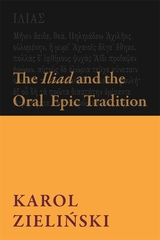 The Iliad and the Oral Epic Tradition
Karol Zieliński
Harvard University Press, 2023 The Iliad reveals a traditional oral poetic style, but many researchers believe that the poem cannot be treated as solely a product of oral tradition. In The Iliad and the Oral Epic Tradition, Karol Zieliński argues that neither Homer’s unique artistry nor references to events known from other songs necessarily indicate the use of writing in its composition. The development of traditional oral cycles suggests that the Iliad is only one of many possible retellings of the story of the Trojan War, in this case with Achilles playing the role of protagonist.
The singer has at his disposal a wide range of techniques to attract and arouse the attention of his listeners. He builds on their knowledge of traditional tales—such as the death of Achilles—in all their various forms, as they exist in the collective memory of the society. The singer may intentionally remodel central characters like Achilles, Odysseus, or Paris, without changing their traditional roles or their destinies. As Zieliński demonstrates, the oral poet can alter the plot of a traditional episode as well as transform its ideological significance. Every cyclic song echoes the story of the entire war, even as it depicts only one episode, traditionally extracted from the beginning or the end of the macro-story.
IJAL vol 80 num 1
The University of Chicago Press
University of Chicago Press Journals, 2013
IJAL vol 80 num 2
The University of Chicago Press
University of Chicago Press Journals, 2013
IJAL vol 80 num 3
The University of Chicago Press
University of Chicago Press Journals, 2013
IJAL vol 80 num 4
The University of Chicago Press
University of Chicago Press Journals, 2013
IJAL vol 81 num 1
The University of Chicago Press
University of Chicago Press Journals, 2015
IJAL vol 81 num 2
The University of Chicago Press
University of Chicago Press Journals, 2015 This is volume 81 issue 2 of International Journal of American Linguistics. The International Journal of American Linguistics (IJAL) is dedicated to the documentation and analysis of the indigenous languages of the Americas. Founded by Franz Boas and Pliny Earle Goddard in 1917, the journal focuses on the linguistics of American Indigenous languages. IJAL is an important repository for research based on field work and archival materials on the languages of North and South America.
IJAL vol 81 num 3
The University of Chicago Press
University of Chicago Press Journals, 2015
IJAL vol 81 num 4
The University of Chicago Press
University of Chicago Press Journals, 2015 This is volume 81 issue 4 of International Journal of American Linguistics. The International Journal of American Linguistics (IJAL) is dedicated to the documentation and analysis of the indigenous languages of the Americas. Founded by Franz Boas and Pliny Earle Goddard in 1917, the journal focuses on the linguistics of American Indigenous languages. IJAL is an important repository for research based on field work and archival materials on the languages of North and South America.
IJAL vol 82 num 1
The University of Chicago Press
University of Chicago Press Journals, 2016
IJAL vol 82 num 2
The University of Chicago Press
University of Chicago Press Journals, 2016
IJAL vol 82 num 3
The University of Chicago Press
University of Chicago Press Journals, 2016 This is volume 82 issue 3 of International Journal of American Linguistics. The International Journal of American Linguistics (IJAL) is dedicated to the documentation and analysis of the indigenous languages of the Americas. Founded by Franz Boas and Pliny Earle Goddard in 1917, the journal focuses on the linguistics of American Indigenous languages. IJAL is an important repository for research based on field work and archival materials on the languages of North and South America.
IJAL vol 82 num 4
The University of Chicago Press
University of Chicago Press Journals, 2016 This is volume 82 issue 4 of International Journal of American Linguistics. The International Journal of American Linguistics (IJAL) is dedicated to the documentation and analysis of the indigenous languages of the Americas. Founded by Franz Boas and Pliny Earle Goddard in 1917, the journal focuses on the linguistics of American Indigenous languages. IJAL is an important repository for research based on field work and archival materials on the languages of North and South America.
IJAL vol 83 num 1
The University of Chicago Press
University of Chicago Press Journals, 2017
IJAL vol 83 num 2
The University of Chicago Press
University of Chicago Press Journals, 2017
IJAL vol 83 num 3
The University of Chicago Press
University of Chicago Press Journals, 2017
IJAL vol 83 num 4
The University of Chicago Press
University of Chicago Press Journals, 2017
IJAL vol 83 num S1
The University of Chicago Press
University of Chicago Press Journals, 2017
IJAL vol 84 num 1
The University of Chicago Press
University of Chicago Press Journals, 2018
IJAL vol 84 num 2
The University of Chicago Press
University of Chicago Press Journals, 2018
IJAL vol 84 num 3
The University of Chicago Press
University of Chicago Press Journals, 2018
IJAL vol 84 num 4
The University of Chicago Press
University of Chicago Press Journals, 2018 This is volume 84 issue 4 of International Journal of American Linguistics. The International Journal of American Linguistics (IJAL) is dedicated to the documentation and analysis of the indigenous languages of the Americas. Founded by Franz Boas and Pliny Earle Goddard in 1917, the journal focuses on the linguistics of American Indigenous languages. IJAL is an important repository for research based on field work and archival materials on the languages of North and South America.
IJAL vol 84 num S1
The University of Chicago Press
University of Chicago Press Journals, 2018
IJAL vol 85 num 1
The University of Chicago Press
University of Chicago Press Journals, 2019
IJAL vol 85 num 2
The University of Chicago Press
University of Chicago Press Journals, 2019 This is volume 85 issue 2 of International Journal of American Linguistics. The International Journal of American Linguistics (IJAL) is dedicated to the documentation and analysis of the indigenous languages of the Americas. Founded by Franz Boas and Pliny Earle Goddard in 1917, the journal focuses on the linguistics of American Indigenous languages. IJAL is an important repository for research based on field work and archival materials on the languages of North and South America.
IJAL vol 85 num 3
The University of Chicago Press
University of Chicago Press Journals, 2019
IJAL vol 85 num 4
The University of Chicago Press
University of Chicago Press Journals, 2019
IJAL vol 85 num S1
The University of Chicago Press
University of Chicago Press Journals, 2019
IJAL vol 86 num 1
The University of Chicago Press
University of Chicago Press Journals, 2020
IJAL vol 86 num 2
The University of Chicago Press
University of Chicago Press Journals, 2020
IJAL vol 86 num 3
The University of Chicago Press
University of Chicago Press Journals, 2020
IJAL vol 86 num 4
The University of Chicago Press
University of Chicago Press Journals, 2020 This is volume 86 issue 4 of International Journal of American Linguistics. The International Journal of American Linguistics (IJAL) is dedicated to the documentation and analysis of the indigenous languages of the Americas. Founded by Franz Boas and Pliny Earle Goddard in 1917, the journal focuses on the linguistics of American Indigenous languages. IJAL is an important repository for research based on field work and archival materials on the languages of North and South America.
IJAL vol 86 num S1
The University of Chicago Press
University of Chicago Press Journals, 2020
IJAL vol 87 num 1
The University of Chicago Press
University of Chicago Press Journals, 2021 This is volume 87 issue 1 of International Journal of American Linguistics. The International Journal of American Linguistics (IJAL) is dedicated to the documentation and analysis of the indigenous languages of the Americas. Founded by Franz Boas and Pliny Earle Goddard in 1917, the journal focuses on the linguistics of American Indigenous languages. IJAL is an important repository for research based on field work and archival materials on the languages of North and South America.
IJPS vol 174 num 1
The University of Chicago Press
University of Chicago Press Journals, 2013
IJPS vol 174 num 2
The University of Chicago Press
University of Chicago Press Journals, 2013
IJPS vol 174 num 3
The University of Chicago Press
University of Chicago Press Journals, 2013
IJPS vol 174 num 4
The University of Chicago Press
University of Chicago Press Journals, 2013
IJPS vol 174 num 5
The University of Chicago Press
University of Chicago Press Journals, 2013
IJPS vol 174 num 6
The University of Chicago Press
University of Chicago Press Journals, 2013
IJPS vol 174 num 7
The University of Chicago Press
University of Chicago Press Journals, 2013
IJPS vol 174 num 8
The University of Chicago Press
University of Chicago Press Journals, 2013
IJPS vol 174 num 9
The University of Chicago Press
University of Chicago Press Journals, 2013
IJPS vol 175 num 1
The University of Chicago Press
University of Chicago Press Journals, 2014
IJPS vol 175 num 2
The University of Chicago Press
University of Chicago Press Journals, 2014
IJPS vol 175 num 3
The University of Chicago Press
University of Chicago Press Journals, 2014
IJPS vol 175 num 4
The University of Chicago Press
University of Chicago Press Journals, 2014
IJPS vol 175 num 5
The University of Chicago Press
University of Chicago Press Journals, 2014
IJPS vol 175 num 6
The University of Chicago Press
University of Chicago Press Journals, 2014
IJPS vol 175 num 7
The University of Chicago Press
University of Chicago Press Journals, 2014
IJPS vol 175 num 8
The University of Chicago Press
University of Chicago Press Journals, 2014
IJPS vol 175 num 9
The University of Chicago Press
University of Chicago Press Journals, 2014
IJPS vol 176 num 1
The University of Chicago Press
University of Chicago Press Journals, 2015
IJPS vol 176 num 2
The University of Chicago Press
University of Chicago Press Journals, 2015
IJPS vol 176 num 3
The University of Chicago Press
University of Chicago Press Journals, 2015
IJPS vol 176 num 4
The University of Chicago Press
University of Chicago Press Journals, 2015
IJPS vol 176 num 5
The University of Chicago Press
University of Chicago Press Journals, 2015
IJPS vol 176 num 6
The University of Chicago Press
University of Chicago Press Journals, 2015
IJPS vol 176 num 7
The University of Chicago Press
University of Chicago Press Journals, 2015
IJPS vol 176 num 8
The University of Chicago Press
University of Chicago Press Journals, 2015
IJPS vol 176 num 9
The University of Chicago Press
University of Chicago Press Journals, 2015
IJPS vol 177 num 1
The University of Chicago Press
University of Chicago Press Journals, 2016
IJPS vol 177 num 2
The University of Chicago Press
University of Chicago Press Journals, 2016
IJPS vol 177 num 3
The University of Chicago Press
University of Chicago Press Journals, 2016
IJPS vol 177 num 4
The University of Chicago Press
University of Chicago Press Journals, 2016
IJPS vol 177 num 5
The University of Chicago Press
University of Chicago Press Journals, 2016
IJPS vol 177 num 6
The University of Chicago Press
University of Chicago Press Journals, 2016
IJPS vol 177 num 7
The University of Chicago Press
University of Chicago Press Journals, 2016
IJPS vol 177 num 8
The University of Chicago Press
University of Chicago Press Journals, 2016
IJPS vol 177 num 9
The University of Chicago Press
University of Chicago Press Journals, 2016
IJPS vol 178 num 1
The University of Chicago Press
University of Chicago Press Journals, 2017
IJPS vol 178 num 2
The University of Chicago Press
University of Chicago Press Journals, 2017
IJPS vol 178 num 3
The University of Chicago Press
University of Chicago Press Journals, 2017
IJPS vol 178 num 4
The University of Chicago Press
University of Chicago Press Journals, 2017
IJPS vol 178 num 5
The University of Chicago Press
University of Chicago Press Journals, 2017
IJPS vol 178 num 6
The University of Chicago Press
University of Chicago Press Journals, 2017
IJPS vol 178 num 7
The University of Chicago Press
University of Chicago Press Journals, 2017
IJPS vol 178 num 8
The University of Chicago Press
University of Chicago Press Journals, 2017
IJPS vol 178 num 9
The University of Chicago Press
University of Chicago Press Journals, 2017
IJPS vol 179 num 1
The University of Chicago Press
University of Chicago Press Journals, 2018
IJPS vol 179 num 2
The University of Chicago Press
University of Chicago Press Journals, 2018
IJPS vol 179 num 3
The University of Chicago Press
University of Chicago Press Journals, 2018
IJPS vol 179 num 4
The University of Chicago Press
University of Chicago Press Journals, 2018
IJPS vol 179 num 5
The University of Chicago Press
University of Chicago Press Journals, 2018
IJPS vol 179 num 6
The University of Chicago Press
University of Chicago Press Journals, 2018
IJPS vol 179 num 7
The University of Chicago Press
University of Chicago Press Journals, 2018
IJPS vol 179 num 8
The University of Chicago Press
University of Chicago Press Journals, 2018
IJPS vol 179 num 9
The University of Chicago Press
University of Chicago Press Journals, 2018
IJPS vol 180 num 1
The University of Chicago Press
University of Chicago Press Journals, 2019
IJPS vol 180 num 2
The University of Chicago Press
University of Chicago Press Journals, 2019
IJPS vol 180 num 3
The University of Chicago Press
University of Chicago Press Journals, 2019
IJPS vol 180 num 4
The University of Chicago Press
University of Chicago Press Journals, 2019
IJPS vol 180 num 5
The University of Chicago Press
University of Chicago Press Journals, 2019
IJPS vol 180 num 6
The University of Chicago Press
University of Chicago Press Journals, 2019
IJPS vol 180 num 7
The University of Chicago Press
University of Chicago Press Journals, 2019
IJPS vol 180 num 8
The University of Chicago Press
University of Chicago Press Journals, 2019
IJPS vol 180 num 9
The University of Chicago Press
University of Chicago Press Journals, 2019
IJPS vol 181 num 1
The University of Chicago Press
University of Chicago Press Journals, 2020
IJPS vol 181 num 2
The University of Chicago Press
University of Chicago Press Journals, 2020
IJPS vol 181 num 3
The University of Chicago Press
University of Chicago Press Journals, 2020
IJPS vol 181 num 4
The University of Chicago Press
University of Chicago Press Journals, 2020
IJPS vol 181 num 5
The University of Chicago Press
University of Chicago Press Journals, 2020
IJPS vol 181 num 6
The University of Chicago Press
University of Chicago Press Journals, 2020
IJPS vol 181 num 7
The University of Chicago Press
University of Chicago Press Journals, 2020
IJPS vol 181 num 8
The University of Chicago Press
University of Chicago Press Journals, 2020
IJPS vol 181 num 9
The University of Chicago Press
University of Chicago Press Journals, 2020
IJPS vol 182 num 1
The University of Chicago Press
University of Chicago Press Journals, 2021
IJPS vol 182 num 2
The University of Chicago Press
University of Chicago Press Journals, 2021
IJPS vol 182 num 3
The University of Chicago Press
University of Chicago Press Journals, 2021
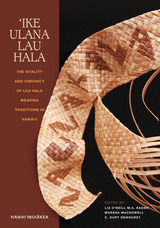 Ike Ulana Lau Hala: The Vitality and Vibrancy of Lau Hala Weaving Traditions in Hawaii
edited by Lia O'Neill Keawe, Marsha Macdowell, and C. Kurt Dewhurst
University of Hawaii Press, 2014 The weaving of lau hala represents a living tradition borne on the great arc of Pacific voyaging history. This thriving tradition is made immediate by masters of the art who transmit their knowledge to those who are similarly devoted to, and delighted by, the smoothness, softness, and that particular warm fragrance of a woven lau hala treasure. The third volume in the Hawaiʻinuiākea series, ʻIke Ulana Lau Hala is an intriguing collection of articles and images about the Hawaiian tradition of ulana lau hala: the weaving, by hand, of dried Pandanus tectorius leaves.
ʻIke Ulana Lau Hala considers the humble hala leaf through several, very different lenses: an analysis of lau hala items that occur in historic photographs from the Bishop Museum collections; the ecological history on hala in Hawaiʻi and the Pacific including serious challenges to its survival and strategies to prevent its extinction; perspectives–in Hawaiian–of a native speaker from Niʻihau on master weavers and the relationship between teacher and learner; a review–also in Hawaiian– of references to lau hala in poetical sayings and idioms; a survey of lau hala in Hawaiian cultural heritage and the documentation project underway to share the art with a broader audience; and a conversation with a master artisan known for his distinct and intricate construction of the lei hala. Rich with imagery, this extraordinary volume will guide the reader to a better understanding of the cultural scope and importance of lau hala, fostering an appreciation of the level of excellence to which the art of ulana lau hala has risen under the guidance of masters who continue to steer the Hawaiian form of the tradition into the future.
Contributors include: Lia Keawe, Marsha MacDowell, Kurt Dewhurst, Marques Marzan, Jenna Robinson, Betty Kam, Annette Kuʻuipolani Wong, Kekeha Solis, Timothy Gallaher, and Kaiwipuni Lipe with Uncle Roy Benham. The volume is co-edited by Keawe, MacDowell, and Dewhurst.
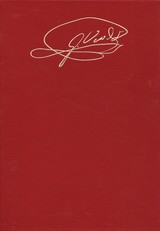 Il corsaro: Melodramma tragico in Three Acts, Libretto by Francesco Maria Piave
Giuseppe Verdi Edited by Elizabeth Hudson
University of Chicago Press, 1998 Although Verdi began sketching the music for Il corsaro in 1846, a lengthy illness forced him to postpone further work. He finally completed the score in early 1848, but the revolutions of that year delayed its first performance. When it finally premiered on 25 October at the Teatro Grande of Trieste Verdi was in Paris and did not participate as usual in the production, which was poorly received. Though more successful in subsequent stagings, Il corsaro was soon eclipsed by the operas of the noted "trilogy" and fell from the repertory.
The full score of Il corsaro, published here for the first time, as well as recent revivals based on pre-publication proofs of this critical edition, reveal the work to be far more rewarding than even Verdi himself would later admit. Showing the gradual consolidation of Verdi's mature style through his contacts with French opera, Il corsaro well repays the renewed attention it is receiving.
 Il Moro: Ellis Heywood's Dialogue in Memory of Thomas More
Ellis Heywood
Harvard University Press, 1972 Readers familiar with Castiglione's The Courtier will welcome this translation of Ellis Heywood's Il Moro, which also uses a conversation among friends as a vehicle for expressing philosophical points of view. Written by an Englishman in Italian, it now makes its first appearance in English translation since it was published in 1556.
In Il Moro Heywood constructs a presumably imaginary debate about the nature of true happiness between his great-uncle Sir Thomas More and six of More's friends. As each speaker presents his views, conflicting currents in Renaissance moral philosophy are made explicit. The merchant Laurence presents the cynical view that men are motivated solely by self-interest and thus seek riches as their greatest happiness; Charles, a dabbler in Neo-Stoicism, argues for virtue and the honor it confers; while Peter defines happiness as based on love, after the fashion of the Neo-Platonists. After these alternatives are dismissed, Leonard maintains that happiness is relative to the individual, Alexander opts for knowledge, and Paul holds forth on the theme that seeking happiness is the worst kind of vanity.
More then reconciles these antagonistic views from the standpoint of a Christian humanist. Happiness, says More, is to be found in the control of appetite by reason, that divine faculty in man which uses the things of this world as instruments for working out the full implications of one's relation to God.
Heywood's principal intention in composing this dialogue about happiness seems to have been to provide posterity with a loving memorial of one of England's greatest humanists. Roger Deakins, in his introduction, discusses the circumstances under which the work was written and sketches the philosophical background in classical, Thomistic, and Renaissance Italian literature. The original Italian text has been reproduced in the back of the volume.
Il trovatore: Critical Edition Study Score
Giuseppe Verdi
University of Chicago Press, 2016 The Works of Giuseppe Verdi is the first critical edition of the composer’s oeuvre. Together with his operas, the series presents his songs, his choral music and sacred pieces, and his string quartet and other instrumental works.
Based on Verdi’s autograph score and an examination of important secondary sources, including contemporary manuscript copies and performing parts, this edition of Il trovatore identifies and resolves numerous ambiguities of harmony, melodic detail, text, and phrasing that have marred previous scores. Scholars and performers alike will find a wealth of information in the critical apparatus to inform their research and interpretations. The introduction to the score outlines the work’s genesis, sources, and performance history, while the critical commentary discusses all editorial decisions.
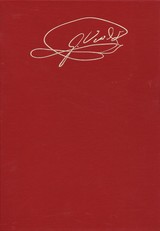 Il trovatore: Dramma in Four Parts by Salvadore Cammarano
Giuseppe Verdi
University of Chicago Press, 1993 Il trovatore, the middle opera of Verdi's famous "trilogy" of the 1850s (with Rigoletto and La traviata), is the sixth work to be published in The Works of Giuseppe Verdi. Based on Verdi's autograph score and an examination of important secondary sources including contemporary manuscript copies and performing parts, the edition identifies and resolves numerous ambiguities of harmony, melodic detail, text, and phrasing that have marred previous scores. Scholars and performers alike will find a wealth of information in the critical apparatus to inform their research and interpretations.
The lengthy introduction to the score discusses the work's genesis, sources, and performance history as well as issues of instrumental and vocal performance practice, production and staging, and problems of notation. As an added feature of the introduction is an original study by Carlos Matteo Mossa of the creation of the libretto, based on the original draft and numerous other autograph documents.
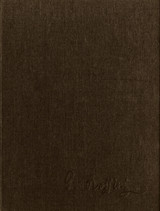 Il viaggio a Reims, ossia L'albergo del giglio d'oro: Dramma giocoso in one act by Luigi Balochi
Gioachino Rossini
University of Chicago Press, 2000 Rossini composed his last Italian opera to celebrate the coronation of the French king Charles X in 1825. A virtuoso tour de force, it was conceived for the greatest voices of the time and calls for an exceptional cast of fourteen soloists: three prima donna sopranos, an alto, two tenors, four baritones, and four basses. One of the score's glories is the audacious "Gran Pezzo Concertato" for the fourteen soloists. In the Finale national toasts derived from patriotic songs set the driving music awhirl.
Rossini permitted only four performances of Viaggio, later reusing half the score for Le Comte Ory. The manuscript sources were presumed lost until part of the autograph was recovered in the 1970s at the Rome Conservatory, while other sources were found in Paris (including original performing parts) and Vienna. The identification of a missing chorus completed the restoration of this magnificent work to the repertory.
Along with the reconstructed score, the critical edition provides historical information about the libretto's relationship to French politics of the era and details on the first production.
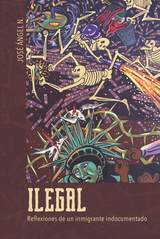 Ilegal: Reflexiones de un inmigrante indocumentado
José Ángel N.
University of Illinois Press, 2019 Por fin disponible en español, Ilegal es el aclamado libro de memorias de José Ángel N., un inmigrante indocumentado que se construyó una vida nueva en Estados Unidos, a donde llegó habiendo cursado la secundaria. N. acogió la educación y de ahí ascendió, de ser aprendiz del inglés como segunda lengua a realizar estudios de posgrado, antes de convertirse en traductor profesional. A pesar de tener un buen trabajo, hubo barreras que lo confinaron a las sombras. La falta de documentación legal le impedía viajar con libertad e incluso comprar una cerveza en un juego de béisbol. A pesar de vivir en un lujoso rascacielos, no puede abrazar completamente el sueño americano. Sin embargo, N. persistió. Esta motivante historia de éxito contradice los estereotipos de los inmigrantes indocumentados a la vez que evidencia cómo la educación puede convertirse en un triunfo ante la adversidad.
José Ángel N. es escritor y traductor. Sus ensayos se han publicado en revistas culturales en México y Estados Unidos. Verónica Murguía es escritora y traductora y radica en México.
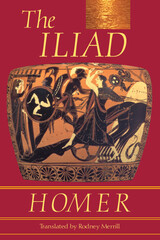 The Iliad
Homer
University of Michigan Press, 2007 "Other competent translations of Homer exist, but none accomplish what Merrill aims for: to convey to the reader-listener in translation the meaning and the sounds of Homer, coming as close as possible to the poetry of the original. Merrill accomplishes this virtuosic achievement by translating Homer's Greek into English hexameters, a process requiring not only a full understanding of the original Greek, but also an unusual mastery of the sounds, rhythms, and
nuances of English."
---Stephen G. Daitz, Professor Emeritus of Classics, City University of New York
Rodney Merrill's translation of Homer's Iliad offers a form of English poetry particularly relevant to the epic, producing a strong musical setting that brings many elements of the narrative truly to life. Most notable are the many battle scenes, in which Homer's strong dactylic hexameters make credible the "war-lust" in the deeds of the combatants.
Until his retirement, Rodney Merrill taught English composition and comparative literature at Stanford and Berkeley. In addition to his translation of Homer's Odyssey, he is the author of "Chaucer's Broche of Thebes."
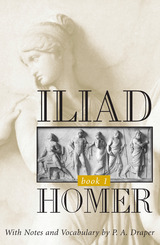 Iliad, Book 1
Homer
University of Michigan Press, 2002 Homer's Iliad has captivated readers and influenced writers and artists for more than two thousand years. Reading the poem in its original language provides an experience as challenging as it is rewarding. Most students encountering Homeric Greek for the first time need considerable help, especially with vocabulary and constructions that differ from the more familiar Attic forms. For anyone who has completed studies in elementary Greek, this edition provides the assistance necessary to read, understand, and appreciate the first book of the Iliad in its original language.
Structured to maximize reading ease, P. A. Draper's volume stands out among introductions to the Greek Iliad. Readers of this edition will appreciate the positioning of all notes facing the Greek text; the frequent vocabulary entries; the complete glossary; the appendix on basic Homeric forms and grammar; and the copious annotations on vocabulary, grammar, meter, historical and mythological allusions, and literary interpretation.
Primarily designed as a textbook, this volume will be an effective classroom tool and a useful acquisition for any library supporting a classics program. The book will find readers among high school and college Greek students, advanced students in Homer or epic poetry classes, graduate students working on reading-list requirements, and anyone interested in maintaining Greek reading skills.
P. A. Draper is Humanities Librarian, Cooper Library, Clemson University.
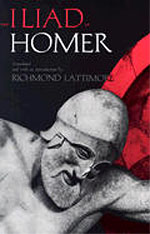 The Iliad of Homer
Translated by Richmond Lattimore
University of Chicago Press, 1951 "The finest translation of Homer ever made into the English language."—William Arrowsmith
"Certainly the best modern verse translation."—Gilbert Highet
"This magnificent translation of Homer's epic poem . . . will appeal to admirers of Homer and the classics, and the multitude who always wanted to read the great Iliad but never got around to doing so."—The American Book Collector
"Perhaps closer to Homer in every way than any other version made in English."—Peter Green, The New Republic
"The feat is decisive that it is reasonable to foresee a century or so in which nobody will try again to put the Iliad in English verse."—Robert Fitzgerald
"Each new generation is bound to produce new translations. [Lattimore] has done better with nobility, as well as with accuracy, than any other modern verse translator. In our age we do not often find a fine scholar who is also a genuine poet and who takes the greatest pains over the work of translation."—Hugh Lloyd-Jones, New York Review of Books
"Over the long haul Lattimore's translation is more powerful because its effects are more subtle."—Booklist
"Richmond Lattimore is a fine translator of poetry because he has a poetic voice of his own, authentic and unmistakable and yet capable of remarkable range of modulation. His translations make the English reader aware of the poetry."—Moses Hadas, The New York Times
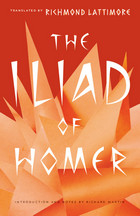 The Iliad of Homer
Homer
University of Chicago Press, 2011 "Sing, goddess, the anger of Peleus’ son Achilleus / and its devastation." For sixty years, that's how Homer has begun the Iliad in English, in Richmond Lattimore's faithful translation—the gold standard for generations of students and general readers.
This long-awaited new edition of Lattimore's Iliad is designed to bring the book into the twenty-first century—while leaving the poem as firmly rooted in ancient Greece as ever. Lattimore's elegant, fluent verses—with their memorably phrased heroic epithets and remarkable fidelity to the Greek—remain unchanged, but classicist Richard Martin has added a wealth of supplementary materials designed to aid new generations of readers. A new introduction sets the poem in the wider context of Greek life, warfare, society, and poetry, while line-by-line notes at the back of the volume offer explanations of unfamiliar terms, information about the Greek gods and heroes, and literary appreciation. A glossary and maps round out the book.
The result is a volume that actively invites readers into Homer's poem, helping them to understand fully the worlds in which he and his heroes lived—and thus enabling them to marvel, as so many have for centuries, at Hektor and Ajax, Paris and Helen, and the devastating rage of Achilleus.
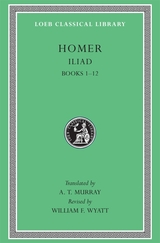 Iliad, Volume I: Books 1–12
Homer
Harvard University Press, 1999 The epic tale of wrath and redemption.
Here is a new Loeb Classical Library edition of Homer’s stirring heroic account of the Trojan war and its passions. The eloquent and dramatic epic poem captures the terrible anger of Achilles, “the best of the Achaeans,” over a grave insult to his personal honor and relates its tragic result: a chain of consequences that proves devastating for the Greek forces besieging Troy, for noble Trojans, and for Achilles himself. The poet gives us compelling characterizations of his protagonists as well as a remarkable study of the heroic code in antiquity.
The works attributed to Homer include the two oldest and greatest European epic poems, the Odyssey and Iliad. These texts have long stood in the Loeb Classical Library with a faithful and literate prose translation by A. T. Murray. William F. Wyatt has brought the Loeb’s Iliad up to date, with a rendering that retains Murray’s admirable style but is worded for today’s readers. The two-volume edition includes an Introduction, helpful notes, and an index.
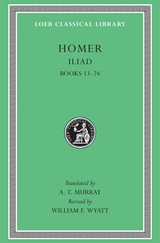 Iliad, Volume II: Books 13–24
Homer
Harvard University Press, 1999 The epic tale of wrath and redemption.
Here is a new Loeb Classical Library edition of Homer’s stirring heroic account of the Trojan war and its passions. The eloquent and dramatic epic poem captures the terrible anger of Achilles, “the best of the Achaeans,” over a grave insult to his personal honor and relates its tragic result: a chain of consequences that proves devastating for the Greek forces besieging Troy, for noble Trojans, and for Achilles himself. The poet gives us compelling characterizations of his protagonists as well as a remarkable study of the heroic code in antiquity.
The works attributed to Homer include the two oldest and greatest European epic poems, the Odyssey and Iliad. These texts have long stood in the Loeb Classical Library with a faithful and literate prose translation by A. T. Murray. William F. Wyatt has brought the Loeb’s Iliad up to date, with a rendering that retains Murray’s admirable style but is worded for today’s readers. The two-volume edition includes an Introduction, helpful notes, and an index.
The Life and Miracles of Thekla: A Literary Study
Scott Fitzgerald Johnson
Harvard University Press, 2006 The Life and Miracles of Thekla offers a unique view on the reception of classical and early Christian literature in Late Antiquity. This study examines the Life and Miracles as an intricate example of Greek writing and attempts to situate the work amidst a wealth of similar literary forms from the classical world. The first half of the Life and Miracles is an erudite paraphrase of the famous second-century Acts of Paul and Thekla. The second half is a collection of forty-six miracles that Thekla worked before and during the composition of the collection.
This study represents a detailed investigation into the literary character of this ambitious Greek work from Late Antiquity.
 I'll Fly Away: A World War II Pilot's Lifetime of Adventures From Biplanes to Jumbo Jets
William Hallstead and Jack Race
University of Scranton Press, 2006 After an exciting career flying dozens of different aircraft to destinations as near as midwestern cornfields and as far as Middle Eastern deserts, veteran aviator Jack Race regales us with his unique experiences in I’ll Fly Away, an engaging biography written with acclaimed novelist William Hallstead.
From his adventures flying for the Allies in World War II to his work as head pilot trainer for Ariana Afghan Airlines, Race has logged more than six decades in the air. I’ll Fly Away tracks his travels around the globe, encompassing his post-war job as crop duster and bush pilot, his thirty-four years as a commercial airline pilot for Pan American World Airways, his consultancy to King Hussein for Royal Jordanian Airlines, and the eight years in which he served as lead pilot for Orbis, an eye hospital on wings that served thirty-one countries. In 1989 Race notably retraced Charles Lindbergh’s 1927 20,000-mile goodwill tour, flying his Spirit of Orbis biplane to all forty-eight of the continental U.S. states.
A remarkable and wholly readable biography of an American original, I’ll Fly Away will be essential for the bookshelf of every aviation enthusiast.
 I’ll Samba Someplace Else: A Spatial History of Race, Ethnicity, and Displacement in São Paulo
Andrew G. Britt
Duke University Press, 2026 In I’ll Samba Someplace Else, Andrew G. Britt maps the interwoven histories of three of the city of São Paulo’s most iconic ethnoracialized neighborhoods, popularly known as “African” Brasilândia, “Japanese” Liberdade, and “Italian” Bexiga. Following these spaces over the mid-twentieth century through inventive methods of spatial history, archival research, and sustained engagement with African descendent cultural organizations, Britt shows that these ethnoracialized neighborhoods did not accrue naturally over time. Instead, they were planned, produced, and contested by an array of individuals, from powerful urbanist-politicians and neighborhood businessowners to celebrated samba composers and historic preservationists. The ethnoracialization of these neighborhoods, Britt argues, served paradoxical ends: they reproduced consequential racialized inequities while, simultaneously, bolstering discourses of multicultural harmony. By untangling the paradoxes of ethnoracial space in Brazil’s most populous, diverse, and unequal city, I’ll Samba Someplace Else elucidates how popular ideologies of multiculturalism endure despite persistently high levels of racialized inequity and anti-Black violence in Brazil and beyond.
Ill Starred General: Braddock of the Coldstream Guards
Lee Mccardell
University of Pittsburgh Press, 1986 A rare combination of documented fact and good storytelling, Ill-Starred General is the biography of a much maligned man from one of history's most vital eras. The career of Edward Braddock began during the court intrigues of Queen Anne and George I, gained momentum in continental military campaigns in the early 1750s, and ended abruptly in the rout of his American army near present-day Pittsburgh in 1755. This highly acclaimed biography reveals the man--and the politics--behind his defeat, one of the major setbacks to British imperial power in the American colonies.
 I'll Take You There: Exploring Nashville's Social Justice Sites
Amie Thurber
Vanderbilt University Press, 2021 Before there were guidebooks, there were just guides—people in the community you could count on to show you around.
I'll Take You There is written by and with the people who most intimately know Nashville, foregrounding the struggles and achievements of people's movements toward social justice. The colloquial use of "I'll take you there" has long been a response to the call of a stranger: for recommendations of safe passage through unfamiliar territory, a decent meal and place to lay one's head, or perhaps a watering hole or juke joint.
In this book, more than one hundred Nashvillians "take us there," guiding us to places we might not otherwise encounter. Their collective entries bear witness to the ways that power has been used by social, political, and economic elites to tell or omit certain stories, while celebrating the power of counternarratives as a tool to resist injustice. Indeed, each entry is simultaneously a story about place, power, and the historic and ongoing struggle toward a more just city for all. The result is akin to the experience of asking for directions in an unfamiliar place and receiving a warm offer from a local to lead you on, accompanied by a tale or two.
I’ll Tell You a Tale: An Anthology
By J. Frank Dobie
University of Texas Press, 1981 I'll Tell You a Tale is a garland of some of Frank Dobie's best writing, put together by Isabel Gaddis, one of his former students at the University of Texas. The tales included are those the author himself liked best, and he even rewrote some of them especially for this anthology. Ben Carlton Mead has contributed 32 original line drawings to illustrate the stories. These tales spring from the soil and folklore of our land; but more than this, they make the readers contemporary with the times, filling us with the wonder of something past and yet still with us. They are arranged topically into sections whose titles speak for them: "The Longhorn Breed," "Mustangs and Mustangers," "The Saga of the Saddle," "Characters and Happenings of Long Ago," "Animals of the Wild," "In Realms of Gold," and "Ironies."
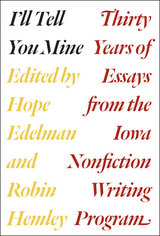 I'll Tell You Mine: Thirty Years of Essays from the Iowa Nonfiction Writing Program
Edited by Hope Edelman and Robin Hemley
University of Chicago Press, 2015 The University of Iowa is a leading light in the writing world. In addition to the Iowa Writers’ Workshop for poets and fiction writers, it houses the prestigious Nonfiction Writing Program (NWP), which was the first full-time masters-granting program in this genre in the United States. Over the past three decades the NWP has produced some of the most influential nonfiction writers in the country.
I’ll Tell You Mine is an extraordinary anthology, a book rooted in Iowa’s successful program that goes beyond mere celebration to present some of the best nonfiction writing of the past thirty years. Eighteen pieces produced by Iowa graduates exemplify the development of both the program and the field of nonfiction writing. Each is accompanied by commentary from the author on a challenging issue presented by the story and the writing process, including drafting, workshopping, revising, and listening to (or sometimes ignoring) advice. The essays are put into broader context by a prologue from Robert Atwan, founding editor of the Best American Essays series, who details the rise of nonfiction as a literary genre since the New Journalism of the 1960s.
Creative nonfiction is the fastest-growing writing concentration in the country, with more than one hundred and fifty programs in the United States. I’ll Tell You Mine shows why Iowa’s leads the way. Its insider’s view of the Iowa program experience and its wealth of groundbreaking nonfiction writing will entertain readers and inspire writers of all kinds.
Ill-Advised: Presidential Health and Public Trust
Robert H. Ferrell
University of Missouri Press, 1996
In Ill-Advised: Presidential Health and Public Trust, now available in paperback, noted historian Robert H. Ferrell presents powerful evidence of frightening medical scandals in the White House. Malpractice, missing public records, and politically motivated cover-ups have hidden sometimes severe presidential illnesses from the American people. Ferrell traces these often shocking incidents--from Grover Cleveland's secret surgery for cancer to the questionable reporting on the health of both Ronald Reagan and George Bush.
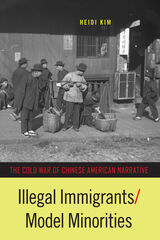 Illegal Immigrants/Model Minorities: The Cold War of Chinese American Narrative
Heidi Kim
Temple University Press, 2021 In the Cold War era, Chinese Americans were caught in a double-bind. The widespread stigma of illegal immigration, as it was often called, was most easily countered with the model minority, assimilating and forming nuclear families, but that in turn led to further stereotypes. In Illegal Immigrants/Model Minorities, Heidi Kim investigates how Chinese American writers navigated a strategy to normalize and justify the Chinese presence during a time when fears of Communism ran high. Kim explores how writers like Maxine Hong Kingston, Jade Snow Wong, and C. Y. Lee, among others, addressed issues of history, family, blood purity, and law through then-groundbreaking novels and memoirs. Illegal Immigrants/Model Minorities also uses legal cases, immigration documents, and law as well as mass media coverage to illustrate how writers constructed stories in relation to the political structures that allowed or disallowed their presence, their citizenship, and their blended identity. Kim illuminates the rapidly shifting political and social pressures on Chinese American authors who selectively concealed, revealed, and reconstructed issues of citizenship, belonging, and inclusion in their writing.
Illegal Migration and Gender in a Global and Historical Perspective
Edited by Marlou Schrover, Joanne van der Leun, Leo Lucassen, and Chris Quispel
Amsterdam University Press, 2008
This incisive volume combines two important issues in contemporary debates over migration: gender and illegal migration. The authors reconsider migration scholarship through the lens of gender in order to investigate definitions of citizenship and the differences in mechanisms of inclusion and exclusion for men and women. Additionally, through applying an interdisciplinary and comparative historical framework that spans the nineteenth and twentieth centuries, the volume also produces a comprehensive account of illegal migration in nations and regions such as the United States, the Middle East, Germany, the Netherlands, Great Britain, Mexico, Malaysia, Pakistan, and the horn of Africa.
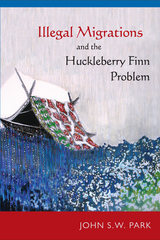 Illegal Migrations and the Huckleberry Finn Problem
John S W Park
Temple University Press, 2013 Throughout American history, citizens have encountered people who are "illegal"-- that is, people who have no legal right to be in the United States or to freedom of movement because of their immigration status or race. Like Mark Twain's Huckleberry Finn, these citizens face the conflict between sympathy for the unlawful other and the force of the law. In Illegal Migrations and the Huckleberry Finn Problem, John Park explores problems of status and illegality in American law and society by examining on-going themes in American legal history, comparative ethnic studies, and American literature. He observes that in reconsidering racially discriminatory laws, Americans have celebrated persons who were "out of status," as well as the citizens who had helped them avoid American law. Similarly, in confronting illegal immigrants in our own time, many Americans have chosen to ignore or to violate federal laws in favor of assisting such persons. In light of these experiences, Park insists that the U.S. ought to rethink policies that have criminalized millions of immigrants, as the injustice of such rules has encouraged people to disobey the law, thereby undermining broader commitments to principles of equality and to the rule of law itself.
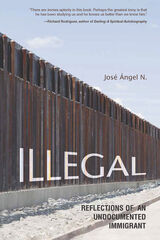 Illegal: Reflections of an Undocumented Immigrant
Jose Angel N.
University of Illinois Press, 2014 A day after José Ángel N. first crossed the United States border from Mexico, he was caught and then released onto the streets of Tijuana. Undeterred, N. crawled back through a tunnel to San Diego, where he entered the United States to stay. Illegal: Reflections of an Undocumented Immigrant is his timely and compelling memoir of building a new life in America. Arriving in the 1990s with a ninth grade education, N. traveled to Chicago where he found access to ESL and GED classes. He eventually attended college and graduate school and became a professional translator. Despite having a well-paying job, N. was isolated by a lack of legal documentation. Travel concerns made promotions impossible. The simple act of purchasing his girlfriend a beer at a Cubs baseball game caused embarrassment and shame when N. couldn't produce a valid ID. A frustrating contradiction, N. lived in a luxury high-rise condo but couldn't fully live the American dream. He did, however, find solace in the one gift America gave him–-his education. Ultimately, N.'s is the story of the triumph of education over adversity. In Illegal, he debunks the stereotype that undocumented immigrants are freeloaders without access to education or opportunity for advancement. With bravery and honesty, N. details the constraints, deceptions, and humiliations that characterize alien life "amid the shadows."
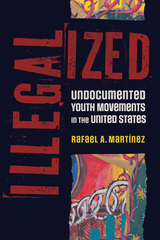 Illegalized: Undocumented Youth Movements in the United States
Rafael A. Martínez
University of Arizona Press, 2024 Illegalized: Undocumented Youth Movements in the United States takes readers on a journey through the history of the rise of undocumented youth social movements in the United States in the twenty-first century. The book follows the documentation trail of undocumented youth activists spanning over two decades of organizing. Each chapter carefully analyzes key organizing strategies used by undocumented youth to produce direct forms of activism that expose and critique repressive forms of state control and violence. This inquiry is particularly generative in relation to how immigrant bodies are erased, contained, and imagined as “aliens” or “illegal.”
Rafael A. Martínez, an undocu-scholar, intricately weaves his lived experience into this deeply insightful exploration. Martínez’s interdisciplinary approach will engage scholars and readers alike, resonating with disciplines such as history, American studies, Chicana and Chicano studies, and borderlands studies.
Illegalized shows that undocumented youth and their activism represent a disruption to the social imaginary of the U.S. nation-state and its figurative and physical borders. It invites readers to explore how undocumented youth activists changed the way immigrant rights are discussed in the United States today.
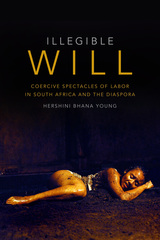 Illegible Will: Coercive Spectacles of Labor in South Africa and the Diaspora
Hershini Bhana Young
Duke University Press, 2017 In Illegible Will Hershini Bhana Young engages with the archive of South African and black diasporic performance to examine the absence of black women's will from that archive. Young argues for that will's illegibility, given the paucity of materials outlining the agency of black historical subjects. Drawing on court documents, novels, photographs, historical records, websites, and descriptions of music and dance, Young shows how black will can be conjured through critical imaginings done in concert with historical research. She critically imagines the will of familiar subjects such as Sarah Baartman and that of obscure figures such as the eighteenth-century slave Tryntjie of Madagascar, who was executed in 1713 for attempting to poison her mistress. She also investigates the presence of will in contemporary expressive culture, such as the Miss Landmine Angola beauty pageant, placing it in the long genealogy of the freak show. In these capacious case studies Young situates South African performance within African diasporic circuits of meaning throughout Africa, North America, and South Asia, demonstrating how performative engagement with archival absence can locate that which was never recorded.
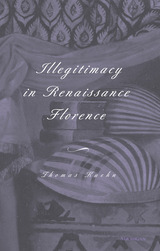 Illegitimacy in Renaissance Florence
Thomas Kuehn
University of Michigan Press, 2002 As far back as Jacob Burckhardt, illegitimate children have been considered advantaged, insofar as they lacked family obligations. Celebrated Renaissance figures such as Petrarch, Boccaccio, Alberti, and da Vinci were born illegitimately. Of course, their status put these children at a legal and a social disadvantage that was nearly impossible to overcome in usual circumstances. Illegitimacy in Renaissance Florence is the first systematic study of a population of illegitimate children--in this case in the city often seen at the heart of Renaissance politics and culture, Florence.
The Florentine catasto, a fiscal survey of households taken at several points in the fifteenth century, locates hundreds of illegitimate children and reveals a great deal about their household circumstances and parentage. Supplementing this information are notarial documents and family account books. Illegitimacy in Renaissance Florence places Florentine illegitimate children in a complete legal context, culminating in examination of several Florentine legal cases. Thomas Kuehn shows how lawyers were called on to cope with and make legal sense of the actions and prejudices of Florentines toward their illegitimate kin.
It is clear, in its simplest terms, that illegitimacy in Florence was a permanent, if not fixed, status. Most illegitimate children, especially girls, were abandoned; infanticide was undoubtedly practiced. But even those children raised by benevolent fathers and granted legitimation always remained "legitimatus" and not "legitimus." Florentines whose illegitimate paternity was admitted were overwhelmingly born of elite fathers but poor or servile mothers. In neither social nor legal terms did the illegitimate share fully in the personhood of the legitimate adult male Florentine citizen. Still, ambiguities of status could be useful for those with sufficient wealth and social standing to exploit their potential.
Illegitimacy in Renaissance Florence will appeal to social historians of Europe, medieval and early modern, especially those concerned with family life, women, and children, as well as all those interested in Florentine history. Legal historians will find it useful as well.
Thomas Kuehn is Professor of History, Clemson University.
Ill-Gotten Gains: Evasion, Blackmail, Fraud, and Kindred Puzzles of the Law
Leo Katz
University of Chicago Press, 1996 In Ill-Gotten Gains, Leo Katz describes the underlying principles that not only guide the law but also moral decisions. Mixing wit with insight, anecdotes with analysis, Katz uncovers what is really at stake in crimes such as insider trading, blackmail, and plagiarism. With its startling conclusions and myriad twists, this book will fascinate all those intrigued by the perplexing relationship between morality and law.
"An ambitious and well-written book of legal and moral theory to overthrow both utilitarianism and its cousin, the economic approach to law."—Richard A. Posner, New Republic
"A good, well-written book full of interesting examples."—Library Journal
"[An] elegant defense of circumvention and subterfuge . . . a heroically counterintuitive book."—Malcolm Gladwell, New Yorker
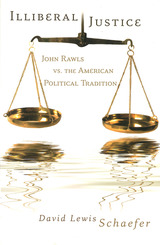 Illiberal Justice: John Rawls vs. the American Political Tradition
David Lewis Schaefer
University of Missouri Press, 2007 Often considered the greatest American political philosopher of the twentieth century, and the most important liberal theorist since John Stuart Mill, John Rawls enjoys a practically sacrosanct status among scholars of political theory, law, and ethics. In Illiberal Justice, David Schaefer offers the most thorough challenge to Rawls’s doctrine yet published, demonstrating how his teachings deviate from the core tradition of constitutional liberalism as exemplified by leading American statesmen from the founders through Lincoln and beyond. Illiberal Justice is the first comprehensive overview of all of Rawls’s writings, emphasizing the continuity in his thought and intention to a greater extent than other scholars have done. Schaefer offers a fundamental critique of both Rawls’s conception of political philosophy and the policy judgments he derives from his “principles of justice.” Schaefer argues that Rawls’s failure to ground his teaching about justice in a serious analysis of human nature or an empirical grasp of political life is symptomatic of a larger crisis within contemporary liberal political and jurisprudential theorizing. Although Rawls is commonly viewed as a welfare-state liberal, Schaefer stresses that his writings actually embody a radical transformation of liberalism in the direction of libertarianism that deviates sharply from the American liberal tradition. Citing empirical evidence of the persistence of political and economic opportunity in America, Schaefer challenges Rawls’s allegations that our polity suffers from grave injustices. He points out the strikingly apocalyptic tone of Rawls’s last writings, in which Rawls even questions whether human existence is worthwhile if his principles are not actualized. Illiberal Justice is not only a critique of Rawls’s political program and philosophic methodology, it is also a defense of the American constitutional order against Rawls’s dogmatic theorizing, which Schaefer argues has exercised an increasing, and detrimental, effect on our jurisprudence. By combining a thorough critical exegesis of Rawls’s texts with a broad engagement with the tradition of political philosophy and American political thought, Schaefer makes an important contribution to both our understanding of Rawls and the enterprise of political philosophy.
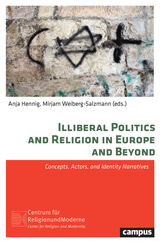 Illiberal Politics and Religion in Europe and Beyond: Concepts, Actors, and Identity Narratives
Edited by Anja Hennig and Mirjam Weiberg-Salzmann
Campus Verlag, 2020 Despite the broadly assumed institutional separation of church and state in contemporary Western politics, there is a trend towards renewed alliances between illiberal interpretations of religion and right-wing populist politics that challenge liberal democracy. This book explores the theoretically and empirically complex ideological, structural, and historical linkage between religion and illiberal politics within a broad range of European states. It shows how political actors apply Christian identity narratives to push exclusionist anti-Muslim politics, while simultaneously showcasing the ways in which religious actors evolve as illiberal players searching for political allies. This timely volume offers a critical look at a key contemporary issue that challenges assumptions and the reputations of current relationships between church and state.
 Illiberal Vanguard: Populist Elitism in the United States and Russia
Alexandar Mihailovic
University of Wisconsin Press, 2023 Recent years have witnessed a growing affinity between increasingly radicalized right-wing movements in the United States and Russia, countries that only recently viewed each other as intractable foes. In Illiberal Vanguard: Populist Elitism in the United States and Russia, Alexandar Mihailovic untangles this confluence, considering ethnonationalist movements in both countries and their parallel approaches to gender, race, and performative identity. Rather than probe specific points of possible contact or political collusion, Mihailovic unveils the mirrored styles of thought that characterize far-right elitism in two erstwhile enemy nations.
Mihailovic investigates notable right-wing actors like Steve Bannon and Alexander Dugin and targets of right-wing ire such as globalization, LGBTQ+ activism, and mobilizations to remove controversial statues (that honor Confederate generals and Soviet leaders, for instance), but the argument extends beyond the specifics. How and why are radical right-wing movements developing along such similar trajectories in two nominally oppositional countries? How do religious sectarianism, the construction of whiteness, and institutionalized homophobia support each other in this transnational, informal, but powerful allegiance? Despite their appeals to populism and flamboyant theatrics, Mihailovic argues, much of the answer can be found in the mutual desire to justify and organize an illiberal vanguard of elite intellectuals, one that supports and advocates for a new authoritarianism.
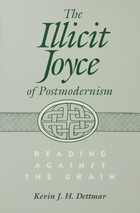 The Illicit Joyce of Postmodernism: Reading Against the Grain
Kevin Dettmar
University of Wisconsin Press, 1996 For nearly three quarters of a century, the modernist way of reading has been the only way of reading James Joyce—useful, yes, and powerful but, like all frameworks, limited. This book takes a leap across those limits into postmodernism, where the pleasures and possibilities of an unsuspected Joyce are yet to be found.
Kevin J. H. Dettmar begins by articulating a stylistics of postmodernism drawn from the key texts of Roland Barthes, Mikhail Bakhtin, and Jean-François Lyotard. Read within this framework, Dubliners emerges from behind its modernist facade as the earliest product of Joyce’s proto-postmodernist sensibility. Dettmar exposes these stories as tales of mystery, not mastery, despite the modernist earmarks of plentiful symbols, allusions, and epiphanies. Ulysses, too, has been inadequately served by modernist critics. Where they have emphasized the work’s ingenious Homeric structure, Dettmar focuses instead upon its seams, those points at which the narrative willfully, joyfully overflows its self-imposed bounds. Finally, he reads A Portrait of the Artist and Finnegans Wake as less playful, less daring texts—the first constrained by the precious, would-be poet at its center, the last marking a surprising retreat from the constantly evolving, vertiginous experience of Ulysses.
In short, The Illicit Joyce of Postmodernism explores what happens when the extra-literary pronouncements of Eliot, Pound, and Joyce, as well as Joyce’s early critics, are set aside and a new, “unauthorized” Joyce is allowed to appear. This postmodern Joyce, more willful and less easily compartmentalized, stands as a counterpoint to the modernist Joyce who has perhaps become too familiar.
An Illini Place: Building the University of Illinois Campus
Incoronata Inserra
University of Illinois Press, 2017 Why does the University of Illinois campus at Urbana-Champaign look as it does today? Drawing on a wealth of research and featuring more than one hundred color photographs, An Illini Place provides an engrossing and beautiful answer to that question. Lex Tate and John Franch trace the story of the university's evolution through its buildings. Oral histories, official reports, dedication programs, and developmental plans both practical and quixotic inform the story. The authors also provide special chapters on campus icons and on the buildings, arenas and other spaces made possible by donors and friends of the university. Adding to the experience is a web companion that includes profiles of the planners, architects, and presidents instrumental in the campus's growth, plus an illustrated inventory of current and former campus plans and buildings.
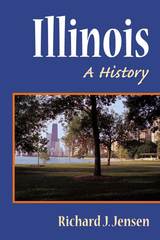 Illinois: A History
Richard J. Jensen
University of Illinois Press, 1978 The epic struggle between traditional, agrarian society and modern industrial capitalism was played out on the national stage as the War between the States. The same struggle between traditional and modern values split Illinois between "Egypt"--the southern region populated by yeoman farmers who came to Illinois from Kentucky, Virginia, Missouri, and other southern states--and the Yankee-dominated, urban north.
Richard J. Jensen treats Illinois as a microcosm of the nation, arguing that its history exhibits basic conflicts that had much to do with shaping American society in general. Northern reformers in Illinois were intent on remaking the state in their image: middle-class, egalitarian, urban, and progressive. These values clashed with the patriarchal supremacy and intense loyalty to kin and ken by which the people of southern Illinois, and the South, organized their lives.
When the Civil War broke out, sympathy for the Confederacy ran high in southern Illinois. Although the region officially supported the Union, guerrilla bands terrorized Unionists, and in Charleston a full-scale riot against Federal troops erupted in 1864. The Union victory decisively shifted both the nation and Illinois toward faster modernization. Violence became more bureaucratized, and localism eroded with the onslaught of chain franchises, consolidated schools, and homogenized suburbs. Jensen extends his discussion to the emergence of newer, postmodern conflicts that continue to occupy the people of Illinois.
Without neglecting the high-profile individuals and events that put the Prairie State on the map, Jensen offers an innovative, wide-angle view that expands our perspective on Illinois history.
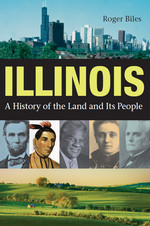 Illinois: A History of the Land and Its People
Roger Biles
Northern Illinois University Press, 2005
Crossroads of the continent, Land of Lincoln, hub of commerce—or, as Charles Dickens viewed it, a landscape "oppressive in its barren monotony"—Illinois boasts a rich and varied past. In this far-reaching but compact history, Roger Biles provides a much-needed, up-to-date account of the state’s development, from the early native settlements to the present. Focusing on Illinois’s demographic changes over time, he highlights the key figures who contributed to the state’s government, economy, culture, and the arts.
While devoting attention to the touchstones of history, Illinois illuminates also the achievements of ordinary people, including the women, the African Americans, and the other minorities who—along with the politicians, the captains of industry, and the military heroes—contributed to the state’s growth and prosperity. National events shaped the state as well, and Biles explores the impact of such crises as the Civil War and World War II on the people of Illinois.
No history of Illinois can ignore the state’s largest city, the dynamic metropolis on Lake Michigan—Chicago. Drawing on extensive research, Biles illuminates Chicago’s past—its outbursts of labor unrest and racial tensions as well as the splendors of two world’s fairs and an artistic renaissance—while at the same time relating Chicago to the larger story of Illinois and its people.
Connecting lesser-known stories with the main events of the state’s past, Biles writes in an accessible style that is at once entertaining and enlightening. Featuring 67 illustrations, Illinois will captivate readers of all ages and interests.
Illinois: Crossroads of a Continent
Lois A. Carrier
University of Illinois Press, 1993 With a major port on the Great Lakes, an extensive network of railroads and canals, and a river system including the Mississippi, the Illinois, and the Ohio, Illinois has long played a critical role in linking East Coast industrial cities, the agricultural heartland, and the Gulf Coast. Writing in a fast-paced, down-to-earth style, Lois Carrier introduces a host of innovations and innovators associated with Illinois: Jane Addams and Louis Armstrong, Frank Lloyd Wright and Walt Disney, Cracker Jack and the Ferris wheel. From the Cahokia Mounds to Chicago, Illinois: Crossroads of a Continent provides a panoramic history for students and general readers.
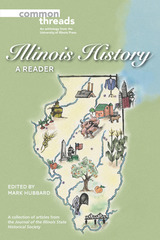 Illinois History: A Reader
Edited by Mark Hubbard: A collection of articles from the Journal of the Illinois State Historical Society
University of Illinois Press, 2018 A renaissance in Illinois history scholarship has sparked renewed interest in the Prairie State's storied past. Students, meanwhile, continue to pursue coursework in Illinois history to fulfill degree requirements and for their own edification.
This Common Threads collection offers important articles from the Journal of the Illinois State Historical Society. Organized as an approachable survey of state history, the book offers chapters that cover the colonial era, early statehood, the Civil War years, the Gilded Age and Progressive eras, World War II, and postwar Illinois. The essays reflect the wide range of experiences lived by Illinoisans engaging in causes like temperance and women's struggle for a shorter workday; facing challenges that range from the rise of street gangs to Decatur's urban decline; and navigating historic issues like the 1822-24 constitutional crisis and the Alton School Case.
Contributors: Roger Biles, Lilia Fernandez, Paul Finkelman, Raymond E. Hauser, Reginald Horsman, Suellen Hoy, Judson Jeffries, Lionel Kimble Jr., Thomas E. Pegram, Shirley Portwood, Robert D. Sampson, Ronald E. Shaw, and Robert M. Sutton.
Illinois in the Civil War
Victor Hicken
University of Illinois Press, 1991 Victor Hicken tells the richly detailed story of the common soldiers who marched from Illinois to fight and die on Civil War battlefields. The second edition of the 1966 classic includes a new preface, twenty-four illustrations, and a twenty-five-page addendum to the bibliography that provides many new sources of information on Illinois regiments.
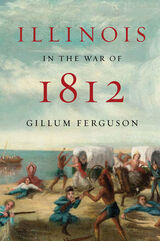 Illinois in the War of 1812
Gillum Ferguson
University of Illinois Press, 2012 Russell P. Strange "Book of the Year" Award from the Illinois State Historical Society, 2012. On the eve of the War of 1812, the Illinois Territory was a new land of bright promise. Split off from Indiana Territory in 1809, the new territory ran from the junction of the Ohio and Mississippi rivers north to the U.S. border with Canada, embracing the current states of Illinois, Wisconsin, and a part of Michigan. The extreme southern part of the region was rich in timber, but the dominant feature of the landscape was the vast tall grass prairie that stretched without major interruption from Lake Michigan for more than three hundred miles to the south. The territory was largely inhabited by Indians: Sauk, Potawatomi, Kickapoo, and others. By 1812, however, pioneer farmers had gathered in the wooded fringes around prime agricultural land, looking out over the prairies with longing and trepidation. Six years later, a populous Illinois was confident enough to seek and receive admission as a state in the Union. What had intervened was the War of 1812, in which white settlers faced both Indians resistant to their encroachments and British forces poised to seize control of the upper Mississippi and Great Lakes. The war ultimately broke the power and morale of the Indian tribes and deprived them of the support of their ally, Great Britain. Sometimes led by skillful tacticians, at other times by blundering looters who got lost in the tall grass, the combatants showed each other little mercy. Until and even after the war was concluded by the Treaty of Ghent in 1814, there were massacres by both sides, laying the groundwork for later betrayal of friendly and hostile tribes alike and for ultimate expulsion of the Indians from the new state of Illinois. In this engrossing new history, published upon the war's bicentennial, Gillum Ferguson underlines the crucial importance of the War of 1812 in the development of Illinois as a state. The history of Illinois in the War of 1812 has never before been told with so much attention to the personalities who fought it, the events that defined it, and its lasting consequences. Endorsed by the Illinois Society of the War of 1812 and the Illinois War of 1812 Bicentennial Commission.
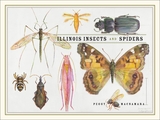 Illinois Insects and Spiders
Paintings by Peggy Macnamara
University of Chicago Press, 2005 Recent estimates put the world's insect population at more than forty million species. Here in Illinois, the numbers are equally awesome: seventeen thousand species call the state home, among them four thousand types of flies; fifteen hundred types of grasshoppers, cicadas, and aphids; five thousand types of beetles; two hundred types of ants, wasps, and bees; and two thousand types of butterflies and moths. With so much entomological diversity here in the Midwest, Illinois residents needn't look further than their own backyards to discover the rich and secret world of insects and spiders.
Marrying art and entomology, Illinois Insects and Spiders is a unique introduction to local biodiversity. Artist Peggy Macnamara celebrates the state's burgeoning insect and spider populations with twenty-seven color plates of beautiful renderings of numerous species, organized both taxonomically and thematically. The insects on each plate are depicted true to scale in relation to one another and are displayed approximately ten times larger than life size. Accompanying each plate are lively captions-written by Field Museum curators and collection managers-that identify the species and reveal their interesting behaviors and unique habitats.
Illinois Insects and Spiders encourages readers to explore the biodiversity at their feet-in the shiny beetles on the ground-and in the air-in the glint of a lightning bug in summer. More than a traditional field guide, Illinois Insects and Spiders is the rare book that combines lush artwork with the science of natural history, bringing both closer to the general reader.
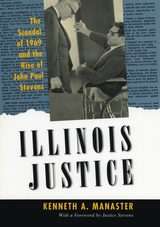 Illinois Justice: The Scandal of 1969 and the Rise of John Paul Stevens
Kenneth A. Manaster
University of Chicago Press, 2001 Illinois political scandals reached new depths in the 1960s and ’70s. In Illinois Justice, Kenneth Manaster takes us behind the scenes of one of the most spectacular. The so-called Scandal of 1969 not only ended an Illinois Supreme Court justice’s aspirations to the US Supreme Court, but also marked the beginning of little-known lawyer John Paul Stevens’s rise to the high court.
In 1969, citizen gadfly Sherman Skolnick accused two Illinois Supreme Court justices of accepting valuable bank stock from an influential Chicago lawyer in exchange for deciding an important case in the lawyer’s favor. The resulting feverish media coverage prompted the state supreme court to appoint a special commission to investigate. Within six weeks and on a shoestring budget, the commission mobilized a small volunteer staff to reveal the facts. Stevens, then a relatively unknown Chicago lawyer, served as chief counsel. His work on this investigation would launch him into the public spotlight and onto the bench.
Manaster, who served on the commission, tells the real story of the investigation, detailing the dead ends, tactics, and triumphs. Manaster expertly traces Stevens’s masterful courtroom strategies and vividly portrays the high-profile personalities involved, as well as the subtleties of judicial corruption. A reflective foreword by Justice Stevens himself looks back at the case and how it influenced his career.
Now the subject of the documentary Unexpected Justice: The Rise of John Paul Stevens, Manaster’s book is both a fascinating chapter of political history and a revealing portrait of the early career of a Supreme Court justice.
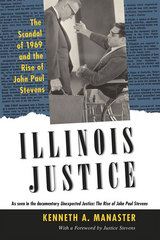 Illinois Justice: The Scandal of 1969 and the Rise of John Paul Stevens
Kenneth A. Manaster
University of Chicago Press, 2001 Illinois political scandals reached new depths in the 1960s and ’70s. In Illinois Justice, Kenneth Manaster takes us behind the scenes of one of the most spectacular. The so-called Scandal of 1969 not only ended an Illinois Supreme Court justice’s aspirations to the US Supreme Court, but also marked the beginning of little-known lawyer John Paul Stevens’s rise to the high court.
In 1969, citizen gadfly Sherman Skolnick accused two Illinois Supreme Court justices of accepting valuable bank stock from an influential Chicago lawyer in exchange for deciding an important case in the lawyer’s favor. The resulting feverish media coverage prompted the state supreme court to appoint a special commission to investigate. Within six weeks and on a shoestring budget, the commission mobilized a small volunteer staff to reveal the facts. Stevens, then a relatively unknown Chicago lawyer, served as chief counsel. His work on this investigation would launch him into the public spotlight and onto the bench.
Manaster, who served on the commission, tells the real story of the investigation, detailing the dead ends, tactics, and triumphs. Manaster expertly traces Stevens’s masterful courtroom strategies and vividly portrays the high-profile personalities involved, as well as the subtleties of judicial corruption. A reflective foreword by Justice Stevens himself looks back at the case and how it influenced his career.
Now the subject of the documentary Unexpected Justice: The Rise of John Paul Stevens, Manaster’s book is both a fascinating chapter of political history and a revealing portrait of the early career of a Supreme Court justice.
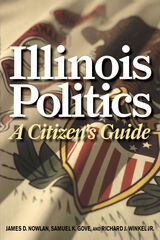 Illinois Politics: A Citizen's Guide
James D. Nowlan, Samuel K. Gove, and Richard J. Winkel
University of Illinois Press, 2010 Considered a microcosm of the nation, the state of Illinois stretches almost four hundred miles from its northern limit at the Wisconsin line to its southern tip at Cairo, nestled between Kentucky and Missouri. Its political culture is as intriguing as the state is long. Illinois has produced presidents and leading members of Congress. It also has a long history of political corruption, including, in recent years, the federal indictments of two consecutive governors. The population of the state is exceptionally diverse, with a significant number of new immigrants. Its political allegiance, once firmly Republican, has trended ever more Democratic. Illinois can be divided neatly into three distinct regions: Chicago, the suburban collar surrounding the city, and the ninety-five downstate counties. Based on the research and experience of respected veterans of Illinois politics, this book shows how the government runs, how politics operates, and what obstacles and opportunities exist for change. It explains how power is exercised and how parties compete for it. For engaged citizens, scholars, and students, Illinois Politics: A Citizen's Guide is a timely and much-needed roadmap for positive change.
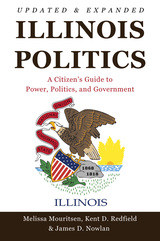 Illinois Politics: A Citizen's Guide to Power, Politics, and Government
Melissa Mouritsen, Kent D. Redfield, and James D. Nowlan
University of Illinois Press, 2024 Shifting demographics. Downstate versus Chicago. Billionaires and bribery. Even veteran observers need a roadmap to track Illinois’ ever-changing political landscape. Melissa Mouritsen, Kent D. Redfield, and James D. Nowlan provide an up-to-date primer on Prairie State politics, government, and policies. Features include: - Discussions of recent events like the 2015-2017 budget disaster, the response to COVID-19, and the fall of longtime House Speaker Michael Madigan;
- New chapters on corruption, social policies, and the political rules of the game;
- Perspectives on the nuts-and-bolts of campaign funding, the ways political actors acquire power or influence, and many other topics;
- Close examinations of complex issues like the state’s increased polarization and its ongoing fiscal recovery.
Fully revised and expanded, <i>Illinois Politics</i> blends detailed information with expert analysis to offer an essential resource for citizens, students, and public servants alike.
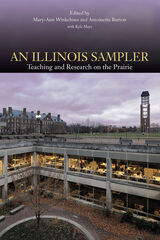 An Illinois Sampler: Teaching and Research on the Prairie
Edited by Mary-Ann Winkelmes and Antoinette Burton with Kyle Mays
University of Illinois Press, 2014 An Illinois Sampler presents personal accounts from faculty members at the University of Illinois at Urbana-Champaign and other contributors about their research and how it enriches and energizes their teaching. Contributors from the humanities, engineering, social and natural sciences, and other disciplines explore how ideas, methods, and materials merge to lead their students down life-changing paths to creativity, discovery, and solutions. Faculty introduce their classes to work conducted from the Illinois prairie to Caribbean coral reefs to African farms, and from densely populated cities to dense computer coding. In so doing they generate an atmosphere where research, teaching, and learning thrive inside a feedback loop of education across disciplines. Aimed at alumni and prospective students interested in the university's ongoing mission, as well as current faculty and students wishing to stay up to date on the work being done around them, An Illinois Sampler showcases the best, the most ambitious, and the most effective teaching practices developed and nurtured at one of the world's premier research universities. Contributors are Nancy Abelmann, Flavia C. D. Andrade, Jayadev Athreya, Betty Jo Barrett, Thomas J. Bassett, Hugh Bishop, Antoinette Burton, Lauren A. Denofrio-Corrales, Lizanne DeStefano, Karen Flynn, Bruce W. Fouke, Rebecca Ginsburg, Julie Jordan Gunn, Geoffrey Herman, Laurie Johnson, Kyle T. Mays, Rebecca Nettl-Fiol, Audrey Petty, Anke Pinkert, Raymond Price, Luisa-Maria Rosu, D. Fairchild Ruggles, Carol Spindel, Mark D. Steinberg, William Sullivan, Richard I. Tapping, Bradley Tober, Agniezska Tuszynska, Bryan Wilcox, Kate Williams, Mary-Ann Winkelmes, and Yi Lu.
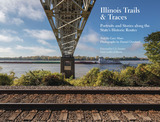 Illinois Trails & Traces: Portraits and Stories along the State’s Historic Routes
Text by Gary Marx and photographs by Daniel Overturf, with a foreword by Dick Durbin
Southern Illinois University Press, 2022 WINNER, 2023 Illinois State Historical Society Superior Achievement Award in “Books, Other”!
FINALIST, 2023 Society of Midland Authors Award in Adult Nonfiction!
Exploring Illinois history through the paths we travel
Illinois Trails & Traces partners the deft writing of Gary Marx with vivid photography by Daniel Overturf to illuminate ever evolving patterns of travel and settlement. Taking the reader on a journey down early buffalo traces and Native American trails, this book shows how these paths evolved into wagon roads and paved highways. Marx and Overturf explore historic routes ranging from Route 66 to the Underground Railroad, all the way back to post-Ice Age animal migration trails followed by Paleo-Indian people. The authors also examine how rivers, canals, and railroads spurred the rapid rise of Illinois as a modern state.
Marx and Overturf bring history into the present by including over forty photographic portraits and written profiles of individuals who live along these routes today. Many of the people you will meet on these pages work to preserve and honor the history of these passages. Others profiled here embody the spirit of the old roads and provide a vivid link between past and present. Through this journey, we discover that we’ve all been traveling the same road all along.
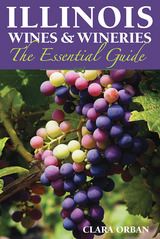 Illinois Wines and Wineries: The Essential Guide
Clara Orban
Southern Illinois University Press, 2014 For more than a century, Illinois has been home to a blossoming wine culture, yet winemaking in the state has not received the attention it deserves. Now, Clara Orban has created the ultimate companion to Illinois wines and wineries. This illustrated volume is a comprehensive yet user-friendly guide for both experienced wine lovers and amateur oenophiles. Orban, a certified sommelier, begins with the history of Illinois wine production and wineries. She then enlightens readers on such wine basics as the most common grapes grown in Illinois, optimal food and wine pairings, the tenets of wine tasting, and provides an overview of the world of labels, bottles, and corks. The fascinating science of wine also is discussed, including the particulars of Illinois soil and climate and their effect on the industry. Orban then provides a guide to all the wineries listed by the Illinois Grape Growers and Vintners’ Association. For each winery, she offers a succinct history, information regarding the variety of grapes used, hours of operation, location, and contact information. In addition to providing readers with a background of the state’s industry and snapshots of individual wineries, Illinois Wines and Wineries provides a glossary of key wine terms, including those specific to the state of Illinois, as well as color photos and a map to each location visited in the book. This sophisticated yet practical guidebook is an essential resource for connoisseurs and casual enthusiasts alike who are interested in exploring Illinois’s rich winemaking legacy.
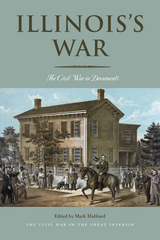 Illinois’s War: The Civil War in Documents
Mark Hubbard
Ohio University Press, 2013 On the eve of the Civil War and after, Illinois was one of the most significant states in the Union. Its history is, in many respects, the history of the Union writ large: its political leaders figured centrally in the war’s origins, progress, and legacies; and its diverse residents made sacrifices and contributions—both on the battlefield and on the home front—that proved essential to Union victory.
The documents in Illinois’s War reveal how the state and its people came to assume such a prominent role in this nation’s greatest conflict. In these crucial decades Illinois experienced its astonishing rise from rural frontier to economic and political powerhouse. But also in these years Illinois was, like the nation itself, a “house divided” over the expansion of slavery, the place of blacks in society, and the policies of the federal government both during and after the Civil War. Illinois’s War illuminates these conflicts in sharp relief, as well as the ways in which Illinoisans united in both saving the Union and transforming their state. Through the firsthand accounts of men and women who experienced these tumultuous decades, Illinois’s War presents the dramatic story of the Prairie State’s pivotal role in the sectional crisis, as well as the many ways in which the Civil War era altered the destiny of Illinois and its citizens.
Illinois’s War is the first book-length history of the state during the Civil War years since Victor Hicken’s Illinois in the Civil War, first published in 1966. Mark Hubbard has compiled a rich collection of letters, editorials, speeches, organizational records, diaries, and memoirs from farmers and workers, men and women, free blacks and runaway slaves, native-born and foreign-born, common soldiers and decorated generals, state and nationally recognized political leaders. The book presents fresh details of Illinois’s history during the Civil War era, and reflects the latest interpretations and evidence on the state’s social and political development.
Illiterate Heart: Poems
Meena Alexander
Northwestern University Press, 2002 Winner, 2002 PEN Open Book Award
Recipient, 2008 Guggenheim Fellowship
Meena Alexander's poetry emerges as a consciousness moving between the worlds of memory and the present, enhanced by multiple languages. Her experience of exile is translated into the intimate exploration of her connections to both India and America. In one poem the thirteenth-century Persian poet Rumi visits with her while she speaks on the phone in her New York apartment, and in another she evokes fellow-poet Allen Ginsberg in the India she herself has left behind. Drawing on the fascinating images and languages of her dual life, Alexander deftly weaves together contradictory geographies, thoughts, and feelings.
The Illiterate Listener: On Music Cognition, Musicality and Methodology
Henkjan Honing
Amsterdam University Press, 2011 We have known for some time that babies possess a keen perceptual sensitivity for the melodic, rhythmic and dynamic aspects of speech and music: aspects that linguists are inclined to categorize under the term ‘prosody’, but which are in fact the building blocks of music. Only much later in a child’s development does he make use of this ‘musical prosody’, for instance in delineating and subsequently recognizing word boundaries. In this essay Henkjan Honing makes a case for ‘illiterate listening’, the human ability to discern, interpret and appreciate musical nuances already from day one, long before a single word has been uttered, let alone conceived. It is the preverbal and preliterate stage that is dominated by musical listening. See also the download version.
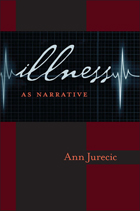 Illness as Narrative
Ann Jurecic
University of Pittsburgh Press, 2012
For most of literary history, personal confessions about illness were considered too intimate to share publicly. By the mid-twentieth century, however, a series of events set the stage for the emergence of the illness narrative. The increase of chronic disease, the transformation of medicine into big business, the women’s health movement, the AIDS/HIV pandemic, the advent of inexpensive paperbacks, and the rise of self-publishing all contributed to the proliferation of narratives about encounters with medicine and mortality.
While the illness narrative is now a staple of the publishing industry, the genre itself has posed a problem for literary studies. What is the role of criticism in relation to personal accounts of suffering? Can these narratives be judged on aesthetic grounds? Are they a collective expression of the lost intimacy of the patient-doctor relationship? Is their function thus instrumental—to elicit the reader’s empathy?
To answer these questions, Ann Jurecic turns to major works on pain and suffering by Susan Sontag, Elaine Scarry, and Eve Sedgwick and reads these alongside illness narratives by Jean-Dominique Bauby, Reynolds Price, and Anne Fadiman, among others. In the process, she defines the subgenres of risk and pain narratives and explores a range of critical responses guided, alternately, by narrative empathy, the hermeneutics of suspicion, and the practice of reparative reading.
Illness as Narrative seeks to draw wider attention to this form of life writing and to argue for new approaches to both literary criticism and teaching narrative. Jurecic calls for a practice that’s both compassionate and critical. She asks that we consider why writers compose stories of illness, how readers receive them, and how both use these narratives to make meaning of human fragility and mortality.
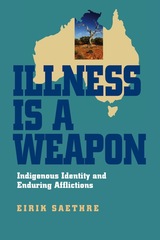 Illness Is a Weapon: Indigenous Identity and Enduring Afflictions
Eirik Saethre
Vanderbilt University Press, 2013 Illness Is a Weapon presents an engaging portrayal of the everyday experience of disease in a remote Australian Aboriginal community. While chronic Aboriginal ill health has become an important national issue in Australia, Saethre breaks new ground by locating sickness within the daily lives of Indigenous people. Drawing on more than a decade of ethnographic research in the Northern Territory, Saethre explores the factors structuring ill health, the tactics individuals use to negotiate these realities, and the ways in which disease and medical narratives are employed to construct, manage, and challenge social relations. Reframing current debates, this book argues that disease and suffering have become powerful expressions of Indigenous identity. Through dialogues and interactions, Aboriginal and non-Aboriginal people engage in a reciprocal discussion about the past, present, and future of indigeneity. Rarely is disease and suffering understood as a form of protest, and in Illness Is a Weapon, Saethre confronts the stark reality of the current contest between all parties in this struggle. As Saethre explains, "Cursing at nurses, refusing to take medication, and accepting acute illness as unremarkable is simultaneously an act of defiance and a rejection of vulnerability."
 Illness or Deviance?: Drug Courts, Drug Treatment, and the Ambiguity of Addiction
Jennifer Murphy
Temple University Press, 2015 Is drug addiction a disease that can be treated, or is it a crime that should be punished? In her probing study, Illness or Deviance?, Jennifer Murphy investigates the various perspectives on addiction, and how society has myriad ways of handling it—incarcerating some drug users while putting others in treatment.
Illness or Deviance? highlights the confusion and contradictions about labeling addiction. Murphy’s fieldwork in a drug court and an outpatient drug treatment facility yields fascinating insights, such as how courts and treatment centers both enforce the “disease” label of addiction, yet their management tactics overlap treatment with “therapeutic punishment.” The “addict" label is a result not just of using drugs, but also of being a part of the drug lifestyle, by selling drugs. In addition, Murphy observes that drug courts and treatment facilities benefit economically from their cooperation, creating a very powerful institutional arrangement.
Murphy contextualizes her findings within theories of medical sociology as well as criminology to identify the policy implications of a medicalized view of addiction.
Illness Politics and Hashtag Activism
Lisa Diedrich
University of Minnesota Press, 2024 How illness on social media reveals the struggle for care and access against ableism and stigma
Illness Politics and Hashtag Activism explores illness and disability in action on social media, analyzing several popular hashtags as examples of how illness figures in recent U.S. politics. Lisa Diedrich shows how illness- and disability-oriented hashtags serve as portals into how and why illness and disability are sites of political struggle and how illness politics is informed by, intersects with, and sometimes stands in for sexual, racial, and class politics. She argues that illness politics is central—and profoundly important—to both mainstream and radical politics, and she investigates the dynamic intersection of media and health and health-activist practices to show the ways their confluence affects our perception and understanding of illness.
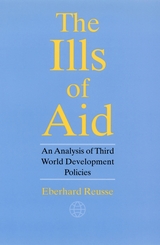 The Ills of Aid: An Analysis of Third World Development Policies
Eberhard Reusse
University of Chicago Press, 2002 With this book, Eberhard Reusse channels thirty years of experience with international aid programs into the task of both diagnosing the problems afflicting these programs and formulating a possible cure. Supporting his analysis with detailed case studies of two rural development programs in Africa—the United Nations’ "War on Waste" and cereal banks for small-farmer communities—Reusse reveals a system riddled with flaws. Impatient assumptions, belated and often suppressed recognition of their invalidity, and the perpetuation of unsuitable programs over decades—all are characteristic of the system. Local populations "fail" to participate in programs, or their accumulated firsthand knowledge is ignored and marginalized. Development experts make misjudgments or are adversely pressured by funding concerns. Programs are unevaluated and unaccountable to donors, perpetuating themselves long after they’re proved ineffective or inefficient. And throughout the book, Reusse demonstrates the principal systemic flaw: unrealistic interventionist paradigms—that is, Western notions of Third World realities that misidentify needs for intervention—at the root of most inappropriate development policies. The problems continue to this day.
Very few critiques of foreign development aid have approached the subject from the perspectives of organizational, rural, or epistemic sociology. The Ills of Aid combines all three, and points toward fundamental solutions: more direct accountability to the primary funding base—the international taxpayer—and the privatization of aid. Learned, pragmatic, and important, The Ills of Aid is essential reading for all in the field.Organization, other international and bilateral development programs, and development financing institutions. His field experience embraces more than forty countries.
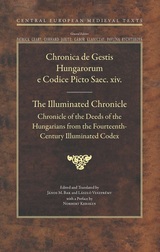 The Illuminated Chronicle: Chronicle of the Deeds of the Hungarians from the Fourteenth-Century Illuminated Codex
János M. Bak
Central European University Press, 2018 The Illuminated Chronicle was composed in 1358 in the international artistic style at the royal court of Louis I of Hungary. Its text, presented here in a new edition and translation, is the most complete record of Hungary's medieval historical tradition, going back to the eleventh century and including the mythical past of its people. The pictures in this manuscript—formerly known as the Vienna Chronicle—are not merely occasional illustrations added to some exemplars, but text and image are closely connected and mutually related to each other, to qualify it as a proper “illuminated chronicle”. The artistic value of the miniatures is quite high, and the characters are drawn with detail and with a knowledge of anatomy. Forty-two of the miniatures are included in the present volume. A full color facsimile will be accessible online. The 147 pictures are an invaluable source of information on late medieval cultural history, costume, and court life. In a historiographical context, The Illuminated Chronicle is an attempt at the popularization of the national history and a systematic appeal to circles beyond the old monastic-clerical audience. The Illuminated Chronicle (Chronica de gestis Hungarorum e codice picto saec. xiv.) is the ninth volume in the Central European Medieval Texts, a Latin–English bilingual series.
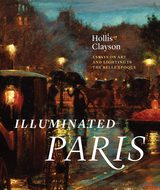 Illuminated Paris: Essays on Art and Lighting in the Belle Époque
Hollis Clayson
University of Chicago Press, 2019 The City of Light. For many, these four words instantly conjure late nineteenth-century Paris and the garish colors of Toulouse-Lautrec’s iconic posters. More recently, the Eiffel Tower’s nightly show of sparkling electric lights has come to exemplify our fantasies of Parisian nightlife. Though we reflect longingly on such scenes, in Illuminated Paris, Hollis Clayson shows that there’s more to these clichés than meets the eye. In this richly illustrated book, she traces the dramatic evolution of lighting in Paris and how artists responded to the shifting visual and cultural scenes that resulted from these technologies. While older gas lighting produced a haze of orange, new electric lighting was hardly an improvement: the glare of experimental arc lights—themselves dangerous—left figures looking pale and ghoulish. As Clayson shows, artists’ representations of these new colors and shapes reveal turn-of-the-century concerns about modernization as electric lighting came to represent the harsh glare of rapidly accelerating social change. At the same time, in part thanks to American artists visiting the city, these works of art also produced our enduring romantic view of Parisian glamour and its Belle Époque.
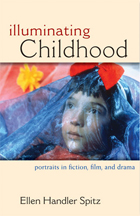 Illuminating Childhood: Portraits in Fiction, Film, and Drama
Ellen Handler Spitz
University of Michigan Press, 2012 "A brilliant and daring book on how art reveals life, how it illuminates childhood beyond what the sciences of development can tell us."
---Jerome Bruner, University Professor, New York University "Combining the surgical precision of a psychoanalytically informed critic with the oracular eloquence of a brilliant close reader, Ellen Handler Spitz reads our cultural fortunes about childhood and parenting through works of art. Moving us (in both senses of the term) from the serene plenitude of Piero della Francesca's Madonna of Childbirth to the unsparing horror of Lessing's Fifth Child, she reveals just how powerfully art puts us in touch with the pulsing energies of real life."
---Maria Tatar, John L. Loeb Professor of Germanic Languages and Literatures, Harvard University "Illuminating Childhood is a wonderfully well-written and researched interdisciplinary study of childhood in various media and mediums as well as through ethnicity, race, gender, cultures, and time."
---T. Denean Sharpley-Whiting, Distinguished Professor of French and Director of African American and Diaspora Studies, Vanderbilt University While literature and the arts are rarely considered primary sources for knowledge about human motivation and behavior, people read novels, attend movies, watch television, and go to the theater not solely to be entertained but also to learn about one another and about themselves. Illuminating Childhood formalizes this quest for psychological knowledge in the domain of the arts. Starting with the premise that a gifted writer, artist, or filmmaker has the ability to teach us as much in one scene as a theorist can in a treatise or a therapist in a session, the author shares her intimate experience of eight thematically linked works in film and literature from the second half of the twentieth century, touching on issues central to parent-child relations, including toxic intrafamilial secrets, the disjunction between love and understanding, and the lasting impact of deceased parents on their children. While the canon of literature about children and parent-child relations includes books that identify problems, propose solutions, and present statistical data, Illuminating Childhood offers a living out of experience via the arts, written for a general audience---parents, teachers, mental health professionals, those who engage with their students via the arts of literature and film, and others. Ellen Handler Spitz holds the Honors College Professorship of Visual Arts at the University of Maryland. She is the author of a number of books on art, psychology, and imagery, including The Brightening Glance: Imagination and Childhood. Her abiding research interests are the cultural lives of young people; the relations between aesthetics and psychology; and the interconnections among literature, music, dance, and the visual arts. Jacket photo: Courtesy of PhotoFest
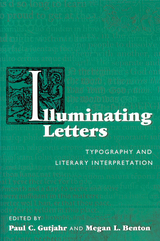 Illuminating Letters: Typography and Literary Interpretation
Paul C. Gutjahr
University of Massachusetts Press, 2001 What do we read when we read a text? The author's words, of course, but is that all? The prevailing publishing ethic has insisted that typography—the selection and arrangement of type and other visual elements on a page—should be an invisible, silent, and deferential servant to the text it conveys.
This book contests that conventional point of view. Looking at texts ranging from the King James Bible to contemporary comic strips, the contributors to Illuminating Letters examine the seldom considered but richly revealing relationships between a text's typography and its literary interpretation. The essays assume no previous typographic knowledge or expertise; instead they invite readers primarily concerned with literary and cultural meanings to turn a more curious eye to the visual and physical forms of a specific text or genre. As the contributors show, closer inspection of those forms can yield fresh insights into the significance of a text's material presentation, leading readers to appreciate better how presentation shapes understandings of the text's meanings and values.
The case studies included in the volume amplify its two overarching themes: one set explores the roles of printers and publishers in manipulating, willingly or not, the meaning and reception of texts through typographic choices; the other group examines the efforts of authors to circumvent or subvert such mediation by directly controlling the typographic presentation of their texts. Together these essays demonstrate that choices about type selection and arrangement do indeed help to orchestrate textual meaning.
In addition to the editors, contributors include Sarah A. Kelen, Beth McCoy, Steven R. Price, Leon Jackson, and Gene Kannenberg Jr.
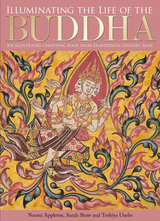 Illuminating the Life of the Buddha: An Illustrated Chanting Book from Eighteenth-Century Siam
Naomi Appleton, Sarah Shaw, and Toshiya Unebe
Bodleian Library Publishing, 2013 Illuminating the Life of the Buddha investigates an outstanding eighteenth-century samut khoi, a type of beautifully illustrated, folded book found in Southeast Asia and popular as a repository for the Buddha’s teachings. Written in Pali and produced in Siam, the samut khoi features finely executed paintings on khoi paper portraying key stories from the Buddha’s past lives. These stories, known as the Jatakas, were the principal means by which Buddhist teachings were communicated and were thus a favored theme for samut khoi. However, this samut khoi stands out for its extensive series of paintings from the last life of the Buddha, including his final awakening and teaching, which are distinctive to the region.
Affording readers immense insight into a spectacular eighteenth-century manuscript, and Thai Buddhist manuscripts and temple culture as a whole, this book will be of great interest to art historians and scholars of Buddhism and Southeast Asia.
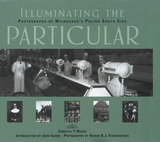 Illuminating the Particular: Photographs of Milwaukee's Polish South Side
Christel T. Maass
Wisconsin Historical Society Press, 2003 Roman B.J. Kwasniewski, son of Polish immigrants, used his camera to document life in Milwaukee's Polish community during the early decades of the twentieth century. His images transform the particulars of everyday life at local businesses, in homes and classrooms, and at cultural, social, and recreational events into powerful depictions of the immigrant experience. With an introduction by well-known Milwaukee historian John Gurda, this book offers rare insight into the daily lives of a proud people struggling to maintain their heritage while living in a time of rapid change.
While Kwasniewski's camera captured the sights and sounds of Milwaukee at the turn of the century from the perspective of a single ethnic group in a single neighborhood, his photographs resonate far beyond Milwaukee's Polish South Side. They illuminate the particulars of American life during the early decades of the twentieth century. "What we see, reflected in the distant mirror," says John Gurda, "is ourselves."
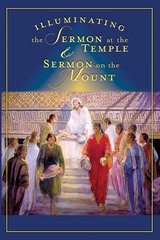 Illuminating the Sermon at the Temple and the Sermon on the Mount
John W. Welch
Foundation for Ancient Research and Mormon Studies, 1999 In 1990 John W. Welch s book The Sermon at the Temple and the Sermon on the Mount presented a thorough Latter-day Saint interpretation of the Savior s greatest sermon, drawing on insights from Jesus s Sermon at the Temple in 3 Nephi to shed light on his Sermon on the Mount in the Gospel of Matthew. Illuminating the Sermon at the Temple and Sermon on the Mount builds on that earlier study with substantial additions based on insights gleaned throughout a decade of continuing research. The basic analysis remains unchanged: understanding the Sermon (meaning both texts in their shared, collective meaning) as a temple text reveals that it has far more power and unity than a mere collection of miscellaneous sayings of Jesus. Seeing the teachings and commandments of the Sermon on the Mount in its Book of Mormon setting at the Nephite temple, in connection with sacred ordinances of covenant making opens new insights into the meaning and significance of the Sermon. In this light, readers never again see the Sermon the same.
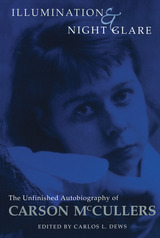 Illumination And Night Glare: The Unfinished Autobiography Of Carson Mccullers
Carson Mccullers
University of Wisconsin Press, 2001 More than thirty years after it was written, the autobiography of Carson McCullers, Illumination and Night Glare, will be published for the first time. McCullers, one of the most gifted writers of her generation—the author of Member of the Wedding, Reflections in a Golden Eye, and The Ballad of Sad Cafe—died of a stroke at the age of fifty before finishing this, her last manuscript. Editor Carlos L. Dews has faithfully brought her story back to life, complete with never-before-published letters between McCullers and her husband Reeves, and an outline of her most famous novel, The Heart Is a Lonely Hunter.
Looking back over her life from a precocious childhood in Georgia to her painful decline from a series of crippling strokes, McCullers offers poignant and unabashed remembrances of her early writing success, her family attachments, a troubled marriage to a failed writer, and friendships with literary and film luminaries (Gypsy Rose Lee, Richard Wright, Isak Dinesen, John Huston, Marilyn Monroe), and the intense relationships of the important women in her life.
 Illuminations: Women Writing on Photography From the 1850s to the Present
Liz Heron and Val Williams, eds.
Duke University Press, 1996 The first anthology of its kind, Illuminations presents a comprehensive selection of women’s writings on photography. It proposes a new and different history by demonstrating the ways in which women’s perspectives have advanced photographic criticism over the last 150 years. Extraordinarily wide-ranging in its scope, this collection chronicles the role of women in photography as critics, historians, and practitioners. Readers will find Julia Margaret Cameron’s bold description of her photographic method, Rosalind Krauss’s exploration of what the camera means for Surrealism, Margaret Bourke-White and Carol Squiers with differing perspectives on Life magazine, as well as essays by Eudora Welty, Susan Sontag, Lucy Lippard, Berenice Abbott, Dorthea Lange, and many others. Illuminations begins with a short piece on the daguerreotype by Elizabeth Barrett Browning then moves through the avant-garde influence of Dada, Bauhaus, and surrealism, to fashion and portrait photography, continuing with documentary and reportage, the emergence of feminist analysis, and postmodern and postcolonial criticism. Encompassing many varied points of view, this volume offers pieces on individual photographers such as Diane Arbus, Ansel Adams, Barbara Kruger, Edward Weston, and Cindy Sherman along with theoretical work by contemporary writers including Jane Gallop, Coco Fusco, and Laura Mulvey. An historic anthology, Illuminations shows that women have been writing about photography from its beginnings and have intervened in the key debates of the past century and a half. It will welcomed by those interested in photography, gender studies, and women and the arts. Contributors. Berenice Abbott, Dawn Ades, Susan H. Aiken, Jan Avgikos, Elizabeth Barrett Browning, Margaret Bourke-White, Deborah Bright, Susan Butler, Julia Margaret Cameron, Cynthia Chris, Louise Dahl-Wolfe, Gen Doy, Olive Edis, Ute Eskildsen, Andrea Fisher, Gisèle Freund, Coco Fusco, Jane Gallop, Nan Goldin, Jewelle Gomez, Jan Zita Grover, Judith Mara Gutman, Maria Morris Hambourg, Liz Heron, Alice Hughes, Karen Knorr, Rosalind Krauss, Annette Kuhn, Dorothea Lange, Therese Lichtenstein, Lucy Lippard, Catherine Lord, Mary Warner Marien, Elizabeth McCausland, Roberta McGrath, Lee Miller, Tina Modotti, Lucia Moholy, Laura Mulvey, Carole Naggar, Nancy Newhall, Amy Rule, Lauren Sedofsky, Ingrid Sischy, Abigail Solomon-Godeau, Susan Sontag, Jo Spence, Carol Squiers, Varvara Stepanova, Anne Tucker, Eudora Welty, Dorothy Wilding, Val Wiliams, Anne-Marie Willis, Madame Yevonde
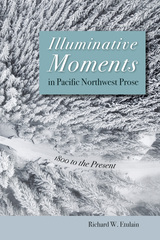 Illuminative Moments in Pacific Northwest Prose: 1800 to the Present
Richard W. Etulain
University of Nevada Press, 2024 Richard W. Etulain examines the emergence of Pacific Northwest prose beginning in the early nineteenth century up to the present. The book provides an introductory overview to a vast subject through “illuminative moments” that illustrate major shifts in the literary history of the region. The book’s focus is on novels, histories, and other nonfiction works that trace Pacific Northwest prose in chronological order through three periods: the frontier, regional, and post-regional eras.
Etulain provides extensive coverage of the writings of notable authors, including novelists Frederic Homer Balch and Mary Hallock Foote, offering an understanding of frontier romantic and Local Color Writers. He also explores the works of H. G. Merriam and novelist H. L. Davis, illustrating regional prose writings. Finally, Etulain includes a panoply of writers who exemplify an emphasis on gender, race and ethnicity, and environmental texts from the post-WWII period.
Illuminative Moments in Pacific Northwest Prose delivers a first-time overview of the region’s literary contributions that will interest both scholars and general readers alike.
 Illusion and Disillusionment: Travel Writing in the Modern Age
Roberta Micallef
Harvard University Press Illusion and Disillusionment: Travel Writing in the Modern Age seeks to understand, expand, and challenge the boundaries of the modern travelogue across several literary traditions. Through an engaging cast of characters—China-bound missionaries, an Indo-Persian diplomat, a Turkish exile in India, a French schoolteacher touring America, Arab students in Moscow, a Japanese woman writer in Europe—this volume extends the study of travel writing beyond the frameworks of colonialism, imperialism, and Orientalism, focusing on the experience of travel itself.
Ranging from the eighteenth to the twentieth centuries, its eight essays analyze travelers from varied nationalities and social backgrounds, who followed different itineraries, used different means of transportation, and wrote for different audiences. The authors place the East and South Asian, Middle Eastern, and European texts and travelers in their socio-historical contexts. Exploring recurrent themes and structures in a set of travel narratives, these essays contribute to broader comparative and cross-cultural studies of travel, self-writing, and transnational lives.
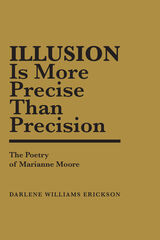 Illusion Is More Precise than Precision: The Poetry of Marianne Moore
Darlene Williams Erickson
University of Alabama Press, 1992 Erickson examines the work of Marianne Moore in order to provide some consistently successful strategies for understanding her poetry In 1935, T.S. Eliot wrote that Marianne Moore’s poems “form part of the small body of durable poetry written in our time.” In this comprehensive critical study of the American poet Marianne Moore (1887-1972) and her work, Erickson amply justifies Eliot’s praise, demonstrating the poet’s ability to combine close observation with a worldview presentation that is at once intuitive, kaleidoscopic, and optimistic. Unfortunately, over the years the excellence and originality of Moore’s work has been overshadowed by its apparent inscrutability. Erickson examines the work of Marianne Moore in order to provide some consistently successful strategies for understanding her poetry.
The thesis is centered in a line from Moore’s poem, “Armor’s Undermining Modesty”:” What is more precise than precision? Illusion.” Erickson argues that Moore came to see herself humorously as “Imagnifico, a Wizard in Words,” a magician who used her conjuries to express a truth beyond reason, a truth described by the philosopher Henri Bergson as intuition, the highest stage of the evolution of human understanding. Is Erickson’s contention that Moore’s sense of magic is inextricably bound up in her own uniquely feminine epistemology, the tendency to place great value on intuition, and to find one’s own voice among collections of many voices.
This study demonstrates that Moore’s voice is arguably the strongest female voice in twentieth century American literature and her poetic voice could hold its own in the company of the best of the other modernists. Unlike many current scholars, Erickson examines closely the texts of Moore’s poems themselves, allowing the poet’s own voice to speak clearly. The study also explores Moore’s obsession with time, her preoccupation with the visual, her interest in the forms of Hebrew verse and her “susceptibility to happiness,” an outlook at some odds with the twentieth century’s fascination with the “romance of failure.”
While the book is scholarly in its intent and carefully documented, it is eminently readable and will be of interest of anyone fascinated by the mind of a brilliant twentieth century woman.
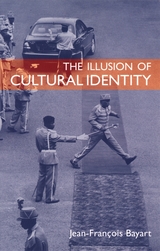 The Illusion of Cultural Identity
Jean-François Bayart
University of Chicago Press, 2005 The concept of cultural identity has become for many a convenient explanation for most of the world's political problems. In The Illusion of Cultural Identity Jean-François Bayart offers a sustained critique of this rationalization by dispelling the notion that fixed cultural identities do, in fact, exist.
In this highly sophisticated book, Bayart shows that the very idea of cultural identity prevents us from grasping the cultural dimensions of political action and economic development. Identities, he argues, are fluid, never homogeneous, and sometimes invented. Political repertoires are instead created through imagined, highly ambiguous aspects of culture—what he calls "imaginaires." For instance, the long beards worn by men in some fundamentalist groups are thought to be key to their core identities and thus assumed to be in conflict with modern values. These beards, however, do not stand in the way of the men's use of technology or their embrace of capitalism—an example Bayart uses to demonstrate the equivocality of cultural identity. The theoretical implications of Bayart's analysis emerge from a fascinating collection of historical examples that often surprise and always instruct.
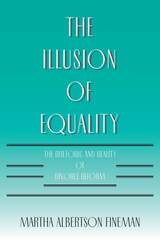 The Illusion of Equality: The Rhetoric and Reality of Divorce Reform
Martha Albertson Fineman
University of Chicago Press, 1991 How do "no-fault," "gender-neutral" divorce reforms actually harm the lives of women and children they are designed to protect? Focusing on the language and symbols of reform, Martha Fineman argues that by advocating measures based on equality of treatment rather than of outcome, liberal feminists disregarded the socioeconomic factors that simultaneously place women at a disadvantage in the market and favor their taking on primary domestic responsibilities. She traces in persuasive detail the detrimental effects of equality rhetoric in shaping divorce law — such as the legal separation of parents' and children's interests; equality replacing need as the prime criterion for settlements; and the increase of state intervention into family life. More than a critique, this book is an incisive argument for adopting outcome-oriented measures and a valuable overview of the pitfalls of uncritically implementing any rhetoric as social policy.
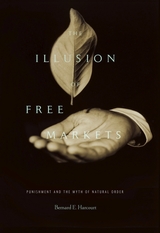 The Illusion of Free Markets: Punishment and the Myth of Natural Order
Bernard E. Harcourt
Harvard University Press, 2011 It is widely believed today that the free market is the best mechanism ever invented to efficiently allocate resources in society. Just as fundamental as faith in the free market is the belief that government has a legitimate and competent role in policing and the punishment arena. This curious incendiary combination of free market efficiency and the Big Brother state has become seemingly obvious, but it hinges on the illusion of a supposedly natural order in the economic realm. The Illusion of Free Markets argues that our faith in “free markets” has severely distorted American politics and punishment practices.
Bernard Harcourt traces the birth of the idea of natural order to eighteenth-century economic thought and reveals its gradual evolution through the Chicago School of economics and ultimately into today’s myth of the free market. The modern category of “liberty” emerged in reaction to an earlier, integrated vision of punishment and public economy, known in the eighteenth century as “police.” This development shaped the dominant belief today that competitive markets are inherently efficient and should be sharply demarcated from a government-run penal sphere.
This modern vision rests on a simple but devastating illusion. Superimposing the political categories of “freedom” or “discipline” on forms of market organization has the unfortunate effect of obscuring rather than enlightening. It obscures by making both the free market and the prison system seem natural and necessary. In the process, it facilitated the birth of the penitentiary system in the nineteenth century and its ultimate culmination into mass incarceration today.
The Illusion of History
Andrew R. Russ
Catholic University of America Press, 2012 Andrew Russ argues in this book that a closer look at their philosophical underpinnings finds that Rousseau, Marx, and Foucault are much less "historical" in their methodology than is widely believed. Instead, they share a more "timeless" view, one indebted to principles ordinarily seen as timeless or transcendent
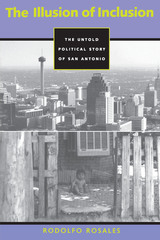 The Illusion of Inclusion: The Untold Political Story of San Antonio
By Rodolfo Rosales
University of Texas Press, 2000 To many observers, the 1981 election of Henry Cisneros as mayor of San Antonio, Texas, represented the culminating victory in the Chicano community's decades-long struggle for inclusion in the city's political life. Yet, nearly twenty years later, inclusion is still largely an illusion for many working-class and poor Chicanas and Chicanos, since business interests continue to set the city's political and economic priorities. In this book, Rodolfo Rosales offers the first in-depth history of the Chicano community's struggle for inclusion in the political life of San Antonio during the years 1951 to 1991, drawn from interviews with key participants as well as archival research. He focuses on the political and organizational activities of the Chicano middle class in the context of post-World War II municipal reform and how it led ultimately to independent political representation for the Chicano community. Of special interest is his extended discussion of the role of Chicana middle-class women as they gained greater political visibility in the 1980s.
 Illusion of Order: The False Promise of Broken Windows Policing
Bernard E. Harcourt
Harvard University Press, 2005 This is the first book to challenge the "broken-windows" theory of crime, which argues that permitting minor misdemeanors, such as loitering and vagrancy, to go unpunished only encourages more serious crime. The theory has revolutionized policing in the United States and abroad, with its emphasis on policies that crack down on disorderly conduct and aggressively enforce misdemeanor laws.
The problem, argues Bernard Harcourt, is that although the broken-windows theory has been around for nearly thirty years, it has never been empirically verified. Indeed, existing data suggest that it is false. Conceptually, it rests on unexamined categories of "law abiders" and "disorderly people" and of "order" and "disorder," which have no intrinsic reality, independent of the techniques of punishment that we implement in our society.
How did the new order-maintenance approach to criminal justice--a theory without solid empirical support, a theory that is conceptually flawed and results in aggressive detentions of tens of thousands of our fellow citizens--come to be one of the leading criminal justice theories embraced by progressive reformers, policymakers, and academics throughout the world? This book explores the reasons why. It also presents a new, more thoughtful vision of criminal justice.
The Illusion of Simple
Charles Forrest Jones
University of Iowa Press, 2022 Byron Caldwell Smith Book Award, Fiction
In a dry Kansas riverbed, a troop of young girls finds a human hand. This discovery leads Billy Spire, the tough and broken sheriff of Ewing County, to investigate and confront the depths of his community and of himself: the racism, the dying economy, the lies and truths of friendship, grievances of the past and present, and even his own injured marriage.
But like any town where people still breathe, there is also love and hope and the possibility of redemption. To flyover folks, Ewing County appears nothing more than a handful of empty streets amid crop circles and the meandering, depleted Arkansas River. But the truth of this place—the interwoven lives and stories—is anything but simple.
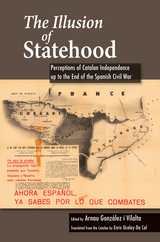 The Illusion of Statehood: Perceptions of Catalan Independence up to the End of the Spanish Civil War
Arnau Gonzàlez I Vilalta
Sussex Academic Press, 2022 In October 1936, as the Spanish Civil War turned a tension in peripheral Europe into a European disaster, the Ministers of Foreign Affairs of Nazi Germany and Fascist Italy signed a series of agreements detailing the need for a common action to prevent the creation and consolidation of a Catalan State. The backdrop to the revolutionary charades, the self-evident dangers of totalitarian states, and the conservative enthusiasms of Franco's Spanish nationalists lay in the potential of Catalonia seceding. What would be the internal and international implications?
The postwar world of 19191923 created political patterns that gave heart to many sub-state nationalisms patterns that hardened into conflictual shape, especially after the rise of Hitler in early 1933. Contributors to the volume trace the convictions of journalists, observers and diplomats that a Catalan split-off was inevitable. But Catalan politics blew in quite another way, later reacting to Soviet dis-interest and British indecisiveness, amongst a host of other pressures. Placing Catalonia and the Catalan nationalist movement in the foreground of contemporary Spanish discourse reveals why present internal complexities require a historical dimension that takes into account early twentieth-century pan-European/ pan-international movements that supported or decried secession, albeit for widely differing nationalist motives. Not least were the perceived and feared reactions of minority populations, and the potential strategic geographic/diplomatic consequences for European leaders. In a way, the unfolding of antagonisms on the international and European scene led to the internal Spanish conflict. The Illusion of Statehood takes the reader away from the bluster of left/right politics and the potentialities of social revolution toward a better understanding of how Catalan independence was viewed by European states and powers. This thoughtfully argued book is essential reading for all historians and students of twentieth-century European history. It provides a much-needed reasoned perspective on the Catalan issue and its historical antecedents.
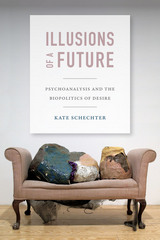 Illusions of a Future: Psychoanalysis and the Biopolitics of Desire
Kate Schechter
Duke University Press, 2014 A pioneering ethnography of psychoanalysis, Illusions of a Future explores the political economy of private therapeutic labor within industrialized medicine. Focusing on psychoanalysis in Chicago, a historically important location in the development and institutionalization of psychoanalysis in the United States, Kate Schechter examines the nexus of theory, practice, and institutional form in the original instituting of psychoanalysis, its normalization, and now its "crisis." She describes how contemporary analysts struggle to maintain conceptions of themselves as capable of deciding what psychoanalysis is and how to regulate it in order to prevail over market demands for the efficiency and standardization of mental health treatments.
In the process, Schechter shows how deeply imbricated the analyst-patient relationship is in this effort. Since the mid-twentieth century, the "real" relationship between analyst and patient is no longer the unremarked background of analysis but its very site. Psychoanalysts seek to validate the centrality of this relationship with theory and, through codified "standards," to claim it as a privileged technique. It has become the means by which psychoanalysts, in seeking to protect their disciplinary autonomy, have unwittingly bound themselves to a neoliberal discourse of regulation.
Illusions of Conflict: Anglo-American Diplomacy Toward Latin America, 1865-1896
Joseph Smith
University of Pittsburgh Press, 1979 This book presents the first comprehensive treatment of Anglo-American rivalry over Latin America in the late nineteenth century, who battled for economic and political influence in the region from the Civil War until 1895, when the Venezuelan boundary dispute came to a head and the Monroe Doctrine was finally recognized by the British. Yet author Joseph Smith posits that this was only an illusion of conflict, that the two major powers has shared objectives all along in the region.
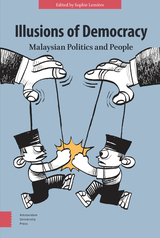 Illusions of Democracy: Malaysian Politics and People
Edited by Sophie Lemière
Amsterdam University Press, 2019 Illusions of Democracy: Malaysian Politics and People offers an up-to-date and broad analysis of the contemporary state of Malaysian politics and society. Transcending disciplinary boundaries, it offers a look at Malaysian politics not only through the lens of political science but also anthropology, cultural studies, international relations, political economy and legal studies touching on both overlooked topics in Malaysian political life as well as the emerging trends which will shape Malaysia’s future. Covering silat martial arts, Malaysia’s constitutional identity, emergency legislation, the South China Sea dilemma, ISIS discourse, zakat payment, the fallout from the 1MDB scandal and Malaysia’s green movement, Illusions of Democracy charts the complex and multi-faceted nature of political life in a semi-authoritarian state, breaking down the illusions which keep it functioning, to uncover the mechanisms which really underlie the paradoxical longevity of Malaysia’s political, economic and social system.
The Illusions of Doctor Faustino
Juan Valera
Catholic University of America Press, 2008 Translated from the Spanish by Robert M. Fedorchek with an introduction by Agnes Moncy
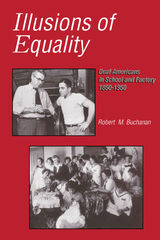 Illusions of Equality: Deaf Americans in School and Factory, 1850-1950
Robert M. Buchanan
Gallaudet University Press, 1999 The working lives of Deaf Americans from the mid-1850s to the post-World War II era depended upon strategies created by Deaf community leaders to win and keep jobs through periods of low national employment as well as high. Deaf people typically sought to de-emphasize their identity as sign language users to be better integrated into the workforce. But in his absorbing new book Illusions of Equality, Robert Buchanan shows that events during the next century would thwart these efforts.
The residential schools for deaf students established in the 19th century favored a bilingual approach to education that stressed the use of American Sign Language while also recognizing the value of learning English. But the success of this system was disrupted by the rise of oralism, with its commitment to teaching deaf children speech and its ban of sign language. Buchanan depicts the subsequent ramifications in sobering terms: most deaf students left school with limited educations and abilities that qualified them for only marginal jobs. He also describes the insistence of the male hierarchy in the Deaf community on defending the tactics of individual responsibility through the end of World War II, a policy that continually failed to earn job security for Deaf workers. Illusions of Equality is an original, edifying work that will be appreciated by scholars and students for years to come.
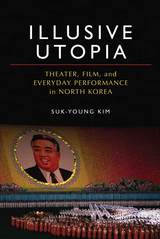 Illusive Utopia: Theater, Film, and Everyday Performance in North Korea
Suk-Young Kim
University of Michigan Press, 2010 "North Korea is not just a security or human rights problem (although it is those things) but a real society. This book gets us closer to understanding North Korea beyond the usual headlines, and does so in a richly detailed, well-researched, and theoretically contextualized way."
---Charles K. Armstrong, Director, Center for Korean Research, Columbia University "One of this book's strengths is how it deals at the same time with historical, geographical, political, artistic, and cultural materials. Film and theatre are not the only arts Kim studies---she also offers an excellent analysis of paintings, fashion, and what she calls 'everyday performance.' Her analysis is brilliant, her insights amazing, and her discoveries and conclusions always illuminating."
---Patrice Pavis, University of Kent, Canterbury No nation stages massive parades and collective performances on the scale of North Korea. Even amid a series of intense political/economic crises and international conflicts, the financially troubled country continues to invest massive amounts of resources to sponsor unflinching displays of patriotism, glorifying its leaders and revolutionary history through state rituals that can involve hundreds of thousands of performers. Author Suk-Young Kim explores how sixty years of state-sponsored propaganda performances---including public spectacles, theater, film, and other visual media such as posters---shape everyday practice such as education, the mobilization of labor, the gendering of social interactions, the organization of national space, tourism, and transnational human rights. Equal parts fascinating and disturbing, Illusive Utopia shows how the country's visual culture and performing arts set the course for the illusionary formation of a distinctive national identity and state legitimacy, illuminating deep-rooted cultural explanations as to why socialism has survived in North Korea despite the fall of the Berlin Wall, the collapse of the Soviet Union, and China's continuing march toward economic prosperity. With over fifty striking color illustrations, Illusive Utopia captures the spectacular illusion within a country where the arts are not only a means of entertainment but also a forceful institution used to regulate, educate, and mobilize the population. Suk-Young Kim is Associate Professor in the Department of Theater and Dance at the University of California, Santa Barbara, and coauthor with Kim Yong of Long Road Home: A Testimony of a North Korean Camp Survivor.
 Illusory Abiding: The Cultural Construction of the Chan Monk Zhongfeng Mingben
Natasha Heller
Harvard University Press, 2014 A groundbreaking monograph on Yuan dynasty Buddhism, Illusory Abiding offers a cultural history of Buddhism through a case study of the eminent Chan master Zhongfeng Mingben. Natasha Heller demonstrates that Mingben, and other monks of his stature, developed a range of cultural competencies through which they navigated social and intellectual relationships. They mastered repertoires internal to their tradition—for example, guidelines for monastic life—as well as those that allowed them to interact with broader elite audiences, such as the ability to compose verses on plum blossoms. These cultural exchanges took place within local, religious, and social networks—and at the same time, they comprised some of the very forces that formed these networks in the first place. This monograph contributes to a more robust account of Chinese Buddhism in late imperial China, and demonstrates the importance of situating monks as actors within broader sociocultural fields of practice and exchange.
The Illustrated Book
Frank Weitenkampf
Harvard University Press A noted authority on the graphic arts here considers the whole field of book illustration, tracing the development of the art and emphasizing some basic principles by a consideration of outstanding illustrated books. It is designed to serve the average reader who wants a crisp summary as well as the student who needs a broad survey that will aid him to pursue the general subject or of some of its branches or bypaths in more detail. There is a wealth of illustrations, culled from masterpieces of the past four centuries.
|
|